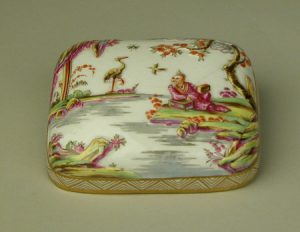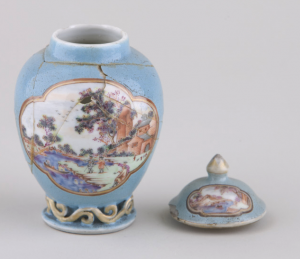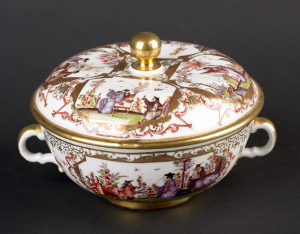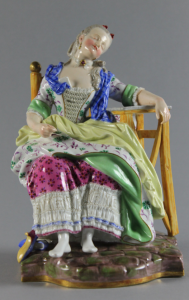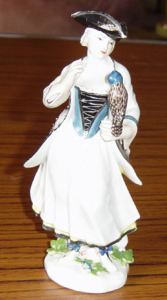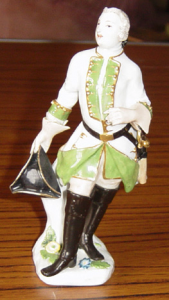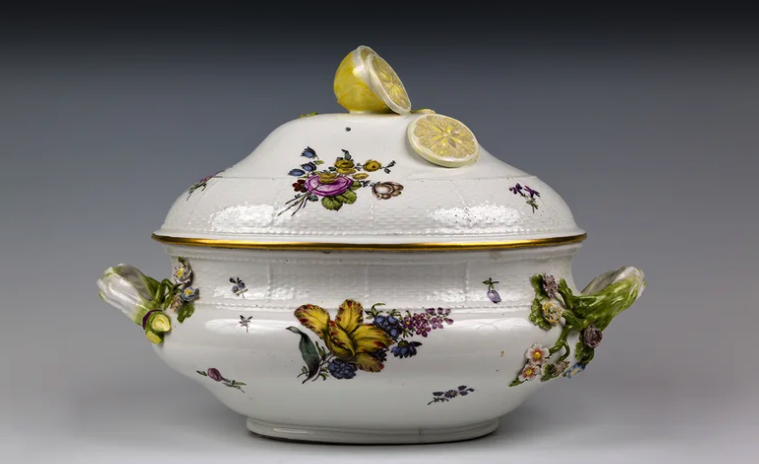
Tureen at Wimpole All images Courtesy of The National Trust
Meissen Porcelain; A world in its own right bought by the highest echelons of British Aristocracy. From the collections seen at the National Trust.
It didn’t take long for the word to spread to the homes of the Aristocracy in England about the invention of hard paste porcelain at Meissen. Not before too long all the most influential families in the countryside wanted to add Meissen to their collections of Oriental Porcelain of China and Japan.
By the nineteenth century nearly every stately home in Britain would have at least one piece of Meissen to display; show off to other members of family and friends. Meissen Porcelain for more than a century had become recognised as an important financial asset. Another reason the name of white gold had become adopted upon Meissen’s inception.
Nevertheless by the time the 19th century had come along the British home would be smothered with a combination of competing ceramic makers of Sevres and a good sample of the main porcelain makers of Bow, Chelsea, Derby, Liverpool, Lowestoft, Plymouth and Worcester.
Had you been alive in the 18th century and wanted to see a sample of how the wealthy enjoyed their lifestyle you would be camping outside of their homes on their lawns or staying nearby at inns. During the 18th century Stately Homes were the museums of the Future.
While some stately homes like Chatsworth have sold off part of their collections, many still retain important reminders of the invention of porcelain in Europe at Meissen.
Where do you go to find Meissen Porcelain if you do not live near a museum in the United Kingdom. At The Meissen Man on this page you can find a list of all the great houses scattered throughout the UK. Each of the houses listed where Meissen is exhibited has a link to the National Trust Website representing the Home where the collection is housed that will have a selection of Meissen Porcelain. See below for image of House together with sample Meissen image and descriptions and Link to Houses Home page.
Comments made about the pieces illustrated are the sole property of The Meissen Man and are expressed as an opinion from trading in Meissen Porcelain since 1980.
Most of the illustrations on this page is of authentic Meissen and the circa dates of each piece are expressed as opinions. There are some items that with what appears to be genuine crossed swords marks but are described as copies. This is expressed so that you can learn about the main copiers of Meissen. Where pertinent there are links to other pages of The Meissen Man Page that give further information relating to the pieces illustrated.
Also included is basic information about how to buy protect and care for your Meissen and other pieces in you collection. The use of illustrations taken from The National Trust Website is for you to further your knowledge about Meissen Porcelain.
Country House Meissen Collection List in Alphabetical Order.
Angelsey Abbey Cambridgeshire
By circa 1735 when this tureen was embellished with a cast lid modelled with stalks of flowers that are likely to have be made later as late as the early 19th century. What makes this tureen very interesting is rather than for the use of a food container it has been changed into a decorative object. The style of painting is after the Japanese Kakiemon. What makes the tureens themselves spectacular is the colourful and almost satyrical faces as handles About 33cm across.
Floral encrustations was another design that was very fashionable during the kaendler Era. While few models exist from the 18th century a number of different designs of floral ornaments embellished with profusely coloured flowers can be seen on this table ornament. Circa 1816. It is very possible that the crossed swords mark on this piece has the non I in roman numerals below the pommels of the cross swords mark. This denotes the age as being circa 1816,
This was a period where Meissen was beginning to experiment with new type of clays and therefore brighter pigments of colour were being painted onto all models that were modelled in this period. This floral table ornament is no exception however the quality is amongst the finest seen during this period. Be aware should your interest be in purchasing such an items if you can be so fortunate to be offered. These objects are very rare and be grateful if there is some restored damage as you may be spending the rest of your life looking for a perfect example. About 26cm Diameter.
Ardress House, County Armagh
These two pairs of table salts of a Man and Woman each holding a basket are not Meissen Porcelain but an exact English Copy taken from a Meissen mould. However, the are also not a fake. In so much as the Maker Bevington had customers who liked to buy his porcelain in the style of Meissen. John Bevington’s mark is quite distinctive when compared to Meissen’s crossed swords mark. See Copy Marks page for more information. The following two pairs are example’s of Bevington’s copies circa 1860.
Trademark of John Bevington who specialised in copying the style of Meissen. His crossed swords mark bears his initials between the ends of the blades.
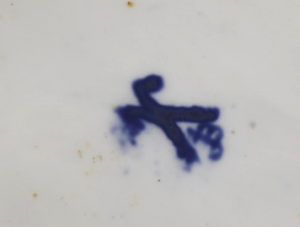
Arlington Court Devon
Meissen was the most popular manufacturer of porcelain in Europe for their first fifty years of production since Bottger experimented with the invention of hard paste porcelain in Europe. However while other European factories began discovered their own method of producing porcelain Meissen would continue to be wanted through three centuries. Every Aristocrat or Royalty around the world wanted to own a piece of Meissen Porcelain.
This Exquisite Ewer and Basin was made for the Turkish Market in the middle of the Marcolini Period circa 1800. The subtle purple palette appears just the ideal colour for this object that not only serves as a Ewer and Basin but was most probably kept for its decorative appeal than actually being used. It was the type of piece that could be sat on a table and admired. Here the use of gilding in the more classical style that was developed at Meissen from the mid 1770’s is seen very evident on this piece as is the beveled modelling. The quality of the floral painting is outstanding for the period.
Berrington Hall Shropshire
Blicking Hall
While not the finest quality of the encrusted table ornaments when compared to the other similar plates seen in other collections. What this does say about the design it was very popular and collectors wanted to have such a design to show off in their co
llection. Just because it is not as profusely decorated shouldn’t be taken as a negative.
This is how it was at Meissen. Not every modeller produced the best that they could model. It is more than likely in the case of this plate the modeller got tired of modelling so many flowers. The manager of the modelling department might have felt an encrusted ornament with less flowers than others may still be very fashionable and sought out by customers. It obviously was because it wouldn’t be sitting here in the collection.
As can be seen are a few chips to petals and stalks that was so common on these designs. circa 1830 25cm diameter
The Nodder or Articulated Pagoda Figure is amongst the most sought after models since originally modelled by Kaendler circa 1745.
The quality of this model is superb. There is only one modeller who was capable of modelling and painting the very finest of models during the fourth quarter of the 19th century. Leuteritz was the head of the modelling department as well as being one of the highest paid employees in the management. His workmanship excelled over most other modellers and artists of the period.
The quality of this nodder speaks for itself. Very sharp details; there rosiness of his cheeks, the sharpness of his eye brows, the redness of his lips and the overall modelling of fingers second to none.
This male model is the middle nodder in the range of sizes 21 cm high. There is a smaller model 15cm high and a larger model 31cm high.
Be aware because the moveable parts; the hands and the tongue in the mouth that flops in and out as do the hands up and down are held in place by lead weights. These are accessible through the hollow base. The crossed swords mark is often seen on the inside of the Nodder but also occasionally on the bottom unglazed foot rim. Minor damage is found on such pieces because of careless handling in the past. See the restoration page to learn about how to care for your Meissen.
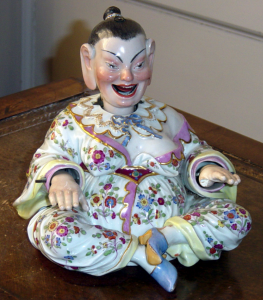 At Meissen the majority of figures and groups were made as pairs or are a part of a series like Italian Comedy (that includes pairs); Criers, Musicians, Seasons etc. See full list of series on series page.
At Meissen the majority of figures and groups were made as pairs or are a part of a series like Italian Comedy (that includes pairs); Criers, Musicians, Seasons etc. See full list of series on series page.
There is normally an easy way to establish whether a pair are matched or original by the painters no that can be identified on the base. Occasionally some items do not have this identification. A pair with identical painters numbers are known as a true pair whereas a pair of figures with different artist numbers are known as matched pairs. Another way of identifying with the difference between the two pairs is that both pairs will have identical colour patterns. However occasionally some pieces are matched so well that it is not so easy to see that they are made by the same artist.
An example of a matched pair where the main ground are the two wall candelabra illustrated below: Two wall sconces are illustrated. See if you can notice the differences that make these two a matched pair as opposed to a true pair?


Borrowdale
This pair of seated figures holding baskets are known as table salts that would have been used as table decoration. Pieces to admire on the dinning room table.
Exact replicas of a man and woman each holding a basket are not Meissen Porcelain but an exact English Copy taken from a Meissen mould. However, this pair are not fake since they carry the maker mark of John Bevington. See the image of the mark that accompanies the pair of salts on in the collection at Ardress House. The mark is quite distinctively different compared to Meissen’s crossed swords mark.
At the beginning of the 2nd quarter of the 19th century there was a lull in the production of figures and groups because the financial climate at Meissen was not at its best and it would not recover until the middle of the century.
During this unfortunate period there was a lot of discontent amongst the painters and modellers who were not getting a well deserved pay packet regularly. As a result employee focus was not about the well being of the factory so that coffers could go into the hands of the management but not back to the employees. Therefore the quality of workmanship suffered greatly. This can be seen in the quality of the clay used, the painting of the crossed swords mark as well as the modelling and painting. The finished article was not to most customer’s taste.
The model of a lady sitting in-between two baskets is evidence of an end of an era of decline and the beginning of making improvements in the design. circa 1850 12 cm high.
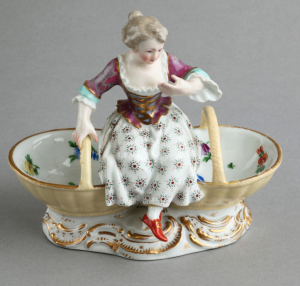
Calke Abbey Derbyhire
One of the many problems facing the novice collector is recognising a Meissen copy when it appears to be genuine. How do you recognise its authenticity. In a nutshell the real and only way is by handling hundreds or more items and acquiring knowledge. When I first began buying and selling Meissen porcelain I was travelling to the US to buy much or my stock. I wasn’t alone as there were plenty of German dealers doing the same in competition to myself. One or two of these dealers are still valued friends of mine.
We were very lucky back then as the lack of knowledge and the inability for local sellers to recognise copies and fakes from authentic Meissen meant we were buying bargains all the time. This of course was back in the 1980’s. However what was very evident too; so called ‘dubious’ specialist dealers selling copies as authentic Meissen and getting away with selling for very high prices to customers who had no knowledge they were not buying the real thing. It was sad and rarely was I able to purchase an genuine piece of Meissen from them because their asking price was far too high. Occasionally thought I would of course pick up a bargain piece of 18th century their lack of knowledge could not recognise.
The following pair of groups are direct copies of a style of Meissen that was very popular. It is only the design around the bases that differs from the Meissen originals. It’s no wonder the unsuspecting customer thought they were buying the genuine article.
In another way mounting this type of group inside of tall glass domes could easily add to the deception. The domes kept any object in pristine condition. But the domes were also very fragile and not easily transportable. Just think of the ‘dubious’ dealer delivering the domes and groups to their customer. The dealer would mount at the desired location where they would be admired. But would anyone ever get to take a look at the marks on the base and recognise the groups were a fake; doubtful!
This pair of groups may look very decorative and beautiful but they are also deceiving in that on the base is a crossed swords mark with a dot between the pommels. The style of the pair are very 19th century. But the mistake the German copiers made at Dresden was not being able to reproduce groupings of figures where the marks actually replicate the date the pieces were supposed to be made. The dot period or punctuation period should be circa 1760. But to be this date would have to be a Rococo design around the base. The more classical look suggests circa 1780 but the actual date this pair of groups would have been closer to 1870 and are not of great quality when compared to even the worst of the Meissen qualities.
Castle Drogo
Ernst August Leuteritz as previously mentioned was one of the most gifted employees in the Meissen Management. He was responsible for achieving perfection in quality of painting never seen before at Meissen. His outstanding workmanship meant all of Meissen’s most important customers wanted a sample of his work.
This superb reticulated dinner plate circa 1880 26cm diameter painted with a scene of a romantic couple out on a fishing date. Standing next to a pony with their dog; the fishing rod seen over the water. Landscape and paintings in the distance. Other scenes that are often found on similar plates are with couples as lovers sitting on a bench in front of a bush. Also seen occasionally with portraits and interior scenes. The dark rich blue is the most popular colour in fashion. What adds to the specialness of the painting on this plate is perfection of the gilding;. so often on Meissen service wares gilding and the blue centre surround is often rubbed away. This may have occurred even before a piece leaves the factory due to carelessness by the stocking wharehouse. This is because these types of wares were kept in stacks. Hopefully there was protection between individual pieces but this may not have always been the case.
Whenever buying such pieces the collector must consider what is acceptable for his collection in regards to wear and tear as opposed to actual damage. What also can be found on these reticulated pieces but not easily noticeable are very small firing cracks in the reticulation. Further restoration will be evident if there is any distinct difference in the colour of the gilding. This is something else to watch out for that some sellers may miss but specialists will always mention.
Chirk Castle Wrexham
Cattle Groups were also very fashionable during the 18th century. Amongst Kaendler’s many models he sought to model figures and groups that catered for every type of customer. This charming group of a milk maid milking a cow while a small girl churns butter. A young man is grasping the cow’s horn.
While the pale blue painting of the crossed swords mark indicates the group was made during the Marcolini period c.1770-80; the actual mark is not at all clear. One way of understanding how Marcolini pieces may differ from copies is the pallet of the overall painting of the piece. If you look closely at the group all the colours are quite pale. The other problem with particular example is the mark itself being not so distinct could be easily missed for crossed swords marks with stars that were painted in Dresden and Paris.
Marcolini Crossed Swords mark.
Clandon House
This Meissen figure of The Greeting Harlequin is amongst one of the most sought after of Italian Comedy Figures circa 1735. A rarer version of the same model came under hammer in Christies in 2007 where it fetched a world record price for a Meissen Figure of £465,00
Peter Reinicke was modeller who worked on the Meissen Monkey Band with the help of Kaendler circa 1755. The Spinet Player is amongst the rarest figures of the Monkey Band Orchestra. 22 Musicians including singers make up a complete band.
Tis Meissen encrusted Equelle and Cover (two handled tureen) was made circa 1750. The beginning of the Punct Period(crossed swords with a dot between the Handles) The was a period at Meissen where newer and more vibrant colours were added. Insects are amongst the many themes seen on Meissen porcelain throughout its history. While raised floral work can be seen on pieces as early as Bottger the fashion of the period was colourful objects.
This Meissen cylindrical vessel may have started off life as a Tankard since it shares a similar shape. Because some of Meissen Porcelain can be very translucent it may be that the ormolu mounts helped this piece serve as a lamp where a candle was placed inside. This piece dates from a period of the 19th century circa 1880 when both painting and modelling excelled. The decoration is a direct copy of pieces made during the 2nd quarter of the 18th century where designs of courtiers amongst architecture or landscape is a common feature.
Kaendler was a master magician when it came to modelling Meissen. He was responsible for more than 2,000 different models including tureens in the shape of many species of birds and animal tureens. This model is of a Quail Tureen circa 1748 15 cm across is modelled so exquisitely sitting on a nest of twigs that forms part of the lower portion of the tureen.
Floral encrustations was another design that was very fashionable during the kaendler Era. While few models exist from the 18th century a number of different designs of floral ornaments embellished with profusely coloured flowers can be seen on this table ornament. Circa 1840 a period in Meissen’s history when the factory was going through some financial hardship. As a consequence of this quality control was not at its best. While the modelling of the individual petals is all hand made the painting in this period of the 19th century was amongst the poorest quality. Even so it is remarkable such pieces survive without much damage. Should you be fortunate to be offered such a piece be grateful that it hasn’t sustained more damage and is a worthy piece to add to any collection. About 26cm Diameter.
While Kaendler was the manager of the modelling department he had many repairers working under him that had a responsibility to paint the faces as well as they could. However, be you a artist or modeller at Meissen was not a well paid profession unless you excelled at work like Kaendler. Therefore the finished quality of any figure varied depending on how the artist felt.
While this charming figure of a lady is sitting leaning back against a post is missing a hand the artist must have been in good form since she appears content. However the shape of the figure looks as though it might have been part of a larger sectional grouping of figures. Circa 1750
This Meissen floral encrusted Vase circa 1880 es a very fine example of modelling under the workmanship of Ernst August Leuteritz who was known to produce some of the finest models Meissen ever modelled during the fourth quarter of the 19th century. If Leuteritz was responsible for the finished product his workmanship was of a quality that Kaendler was to the 18th century. These lavishly painted floral encrustations have been very popular amongst collectors throughout Meissen’s history. There is one drawback to encrusted pieces and that is looking after such pieces with pride. Sadly few pieces survive without andy damage or restoration to the leaves and flowers each of which would been hand modelled separately at the time of making. Expect to find chips to flowers and leaves into today’s international market place.
Coughton Court Warwichsire
During the 18th century Kaendler was very inspired by the decoration at Versailles where Romanticism and Elegance were intertwined. Everything in the 18th century was influenced by the French Court although the decoration was purely a Meissen invention when the artist was not copying patterns that emulated the styles of the Orient; most notably China and Japan.
There were two types of models of baskets in fashion in the middle of the 18th century. There was the types with interwoven reticulation and the other seen in the image below. This was the type of decorative art very popular to be sitting on the dinning room table; perhaps filled with incense or possibly fruit. But it was something to add to the splendour of the dinning room setting.
On purpose the design is not meant to stand out. But the subtle palate would look well on any piece of brown furniture of the period. The basket sits on four feet designed like branch stubs while the handles have the appearance of interwoven vine. Cartouches of roses and raised flowers sparsely decorated adds to the overall beauty that elegance beholds. 31 cm across circa 1760. This was a design that was copied throughout the 19th century and comes in sizes up to 75cm across although this large size is extremely rare.
Cragside Northumberland
The modelling department at Meissen had to cater for almost never ending tastes that the wealthy required to be made in their porcelain. Amongst the designs during the 18th and 19th century was hunting with some pieces illustrating the most gory of bloodstained scenes. Not to everyone’s taste. But that is how it was.
However not all Hunting scenes depicted bloodshed. While the story behind the decoration may indicate an unhappy ending the crafting of the modelling makes it very clear large packs with spectators were sent out to hunt Deer.
18th century versions of this vase and cover are extremely rare. This model was made circa 1870. While the modelling is quite fine it is not as crisp as models made circa 1880; hile only ten years apart. Even so it is an incredible piece of workmanship. The vase stands around 55cm high. On the lid is the God Diana with one of her hunting dogs.
Mostly two types of raised decoration exist on Meissen vases. Floral or Fruit decorated porcelain and occasionally both. The fine quality of these vases determines the workshop of Leuteritz who made all of his porcelains stand out amongst the crowd; this pair are no exception. Decorated with raised models of fruit and flowers amongst green foliage on a white ground patterned glaze 45 cm high. Some damage consistent with the type of chipping seen on most types of objects with encrusted decoration. This pair made in the workshop of Leuteritz circa 1880.
Croome Park Hampshire
Just like finding a correct and official explanation for the meaning of the cancelled crossed swords mark the same can be said for faces with unhappy or sullen expression. There could be two reason one is it was the type of expression expected from customers buying such pieces. Or the unhappy facial expression expressed the sadness in the profession that the model was after.
Here is a reason to own the piece and another not to want to own it. My interest in owning such a piece would be based on the quality of modelling. Another reason the wanting the piece is to be able to add as many genre of design to build a collection. Lastly the reason not to own is finding disappointment whenever looking at the facial expression; perhaps ladies making pastry rarely enjoyed their job.
The figure stands on a marble base that resembles the marble floor or her workplace. The mark seen on the base is useful to identify with pieces made circa 1860. Not the finest of quality but not the poorest.
A few years after I completed the Meissen Collectors Catalogue published 2004 I contemplated writing a new book; “Meissen in the English Home”; to which this page is named after. I was fortunate at this time to visit almost every Stately Home in the UK to see the owner’s collections of Meissen. It was breath taking away material. While the book wasn’t written was probably because the timing wasn’t correct. We are now in the middle of lockdown. The Meissen Market was flourishing around the world until half way through the first decade of the 21st century. Then the decline began because of the none-understanding of what make a piece of Meissen rare or finer quality or perfect if such pieces exist! However new markets were emerging.
During my tour I saw little of 19th century Meissen. Outside of Meissen in Germany few museums dotted around the world have any serious inventories of 19th century Meissen and most certainly there was little in stately homes.
However now is the year 2021 and it appears there is a change in this fashion and more 19th and later Meissen porcelain appears to be finding ways into important collections.
I find it so pleasing now to be able to illustrate both quantities of 18th and 19th century Meissen that people can see in the outstanding collections around the UK.
To see Croome Park illustrating 19th century together with rarities of the 18th century says something about this change in fashion.
The following is a very rare Meissen Vase circa 1735 in the style of the Japanese Kakiemon. Kakiemon was later 17th and early 18th century porcelain made for the elite; the epitome of royalty.
There’s an interesting story that you can find on the Meissen Fraud page by a certain Parisian Merchant who had he had his way and not stopped by August The Strong would have created havoc for the Meissen Management and it was all about the design that is on the vase below. The thing is back then the Japanese Kakiemon was amongst the most prized porcelain available in the fist half of the 18th century. However Meissen copies were far better quality but whose value was a fraction of the Japanese originals. However this French Merchant had found a way he could fool his customers in believing they were buying original Japanese. He had one problem and that was having the Meissen trademark erased. To read the full story and learn about this notorious faker Le Maire click here.
Meissen Hexagonal Kakiemon Style Vase in the Quail Pattern circa 1735 To the untrained eye there is little difference to some of the crossed sword markings that appear on 19th century Meissen. It is no wonder even with genuine Meissen marks there is so much confusion. It is also a reason why I chose not to write an illustrated chapter about the crossed swords mark. The only real way of learning how to accurately date a piece is by the constant handling of such pieces either in a specialised auction or better still at a specialist dealers shop or a study day at a museum.
The painting of the crossed swords mark on the base of the Kakiemon vase below does not look like a complete and authentic Meissen cancelled crossed swords. This is because part of the lines that represents the swords has been rubbed away due to too much inappropriate handling. See the care page to ensure any pieces you may have where the mark is painted on an unglazed base will be long lasting. 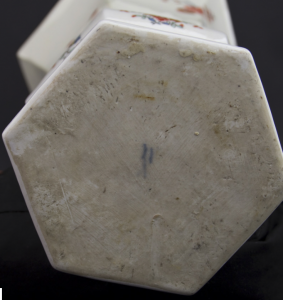
The following two candelabra are each one of a pair but modelled in different times. The top candelabra was modelled by Kaendler while the bottom candelabra was modelled during the Marcolini Period possibly by the modeller Juchzer.
The reason being Kaendler introduced the rococo style into his models whereas Juchzer introduced the classical look into the Marcolini Period.
The Kaendler model dates from circa 1770

Kaendler Candelabra with Punct Period Mark
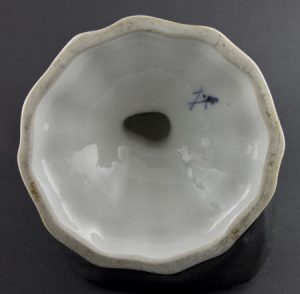
The Juchzer model dates from 1782. The Juchzer See Firing Challenges Page
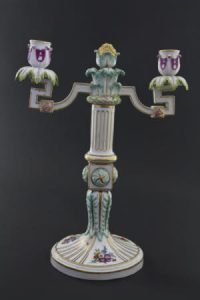
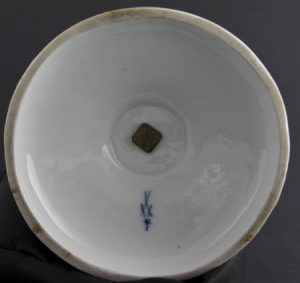
Kaendler was a very ingenious modeller amongst his many talents. He loved to create as many varieties as he could. The following creative model is that of a Lemon modelled as a tureen. This tureen may have been used as much ware is seen on the base and the crossed swords mark is not entirely clear.

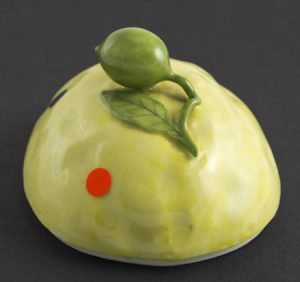
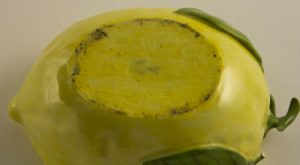
One of the challenges facing a collector is recognising the age of Meissen Porcelain by the style of decoration and not necessarily the mark. Because the Meissen crossed swords is copied by so many other porcelain makers it would be unwise to consider a piece to be genuine by the mark alone.
It is useful when you visit a National Trust Collection and the home as in its collections pieces of Meissen that you can identify with from the different periods. The following tureen and cover dates from the middle of the 19th century. The manner in which the painting of the gilding is thicker than that of the 18th century as well as paler. The crossed swords mark is painted thickly on the base. During the 18th century the crossed swords mark would be much thinner in appearance. See Crossed Swords Trademark page for further information
A Meissen baluster pot painted with bouquets of flowers, blue crossed swords mark, circa 1850.
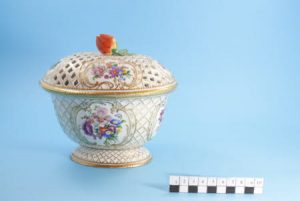
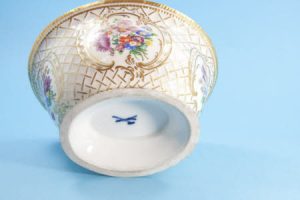
Dorney Wood Buckinghamshire
It is incredible to believe how many different models were produced while Kaedler managed the modelling department. More than 2,000. Its quite an astonishing feat with many hundreds of each item modelled during the period.
However how many survived is another question that probably cannot be answered. So many types of genres of figural, animalia and bird. Swans were seen as amongst the more popular genre. Another reason many were reproduced in the 19th century. Swans generally were kept on mantel pieces or as table decoration to me admired while eating dinner as conversation pieces.
This model of swan sits 26cm high and is a little smaller than the larger size of 31cm. The quality of modelling and painting is not quite as fine a when Leuteritz was manager of the modelling department. This puts a date of circa 1850 after a Kaendler original that dates from the middle of the 18th century.
Dudmaston Shropshire
In this painted porcelain stand are two children. Both of which are a little tubby in appearance. They are supposed to illustrate lovers although of course they are far too young. One has to assume he has upset her or she is disappointed in a remark of his that has made her tearful.
One of the interesting facts about Meissen porcelain is there are so many different and diverse genres of styles and designs that you can collect. This over dish was made circa 1822 as the collection describes. If this is the case then the crossed swords mark would have below the pommels the roman numerals for II. The dullish quality of the painting also illustrates this piece to have been made in this period when many of the pieces made were mostly service wares.
Erddig Denbighshire
This pair of urn shaped vases represent some of Leuteritz early models. These vases were extremely elaborate with their decoration. Large raised encrustations of fruit around the handles and cartouches seen at the top half. Cartouches each illustrating lovers set in romantic outdoor settings was common for this type of decoration. Many of the scenes were copied from the drawings by Watteau.
While the condition in general appears to be good the vases have gone through some wear and tear notably the missing gilding to the foot-rims. However there was another major impectation that is not easily seen. For some inexplicable reason the shape of the vases caused considerable problems for the modeller and more often than not the top rims came out of the oven misshapen.
The painting of these vases illustrates a period of between 1860 and 70 when Meissen began experimenting with new glazes to improve the overall quality.
The pair stand 50cm tall.
I can just imagine how smart a set of these blue and white onion pattern napkin rings could be laid out on a table next to a complete Onion Pattern Dinner Service.
Ironically whereas you may come across thousands of service wares in the onion pattern. More than likely you would struggle to find an antique onion pattern napkin ring just like this one circa 1860.

Felbrigg Hall Norfolk
During the Marcolini period was another era when changes to designs occurred to designs on service wares particularly cups and saucers. The richer cobalt blue was found to be very popular amongst Meissen’s customers and began a new fashion for very colourful and striking cabinet pieces to which this tea bowl and saucer belongs. The wreath on the lid is typical of the Marcolini period. The Marcolini mark would have a star below the pommels of the crossed swords. Buyer beware the Marcolini mark with the star is amongst the most copied of all of Meissen models. Cartouches as seen on the tea bowl were embellished with flowing gilt borders as well as the more classical brick like work painted on the lid.
It is very possible the saucer belongs to the tea bowl since it has a matching style although more often than not designs on lids normally match the saucers but the design on the saucer is very typical of designs seen on many similar Marcolini period cabinet service wares.
If you were to look at the two dinner plates below which of the birds would you think is the rarer of the two ; the bird in the centre or the owl it would have been very ordinary. Owl’s are always considered a rarity in the wild and likewise they are a rarity in decoration on dinner plates.
You can slo see on both plates what appears to look like creamy discolouration. This could be one of two things wear and tear and a build up of grime or poor restoration that has turned from what is supposed to be invisible to the eye to discolouration visible. Restoration rarely lasts for years but the best restoration will last longer; but the best will cost more to restore. Circa 1750-60; 24 cm diameter
The dinner plate below is a traditional design often found on Meissen service wares that were likely to have been made for actual use. Often close examination of this types of wares will see scratches to the surface of the glaze. Another striking feature that makes the design on this plate different from the norm is the painting of an insect appearing to almost sit on a elongated shaped leaf. Circa 1755 24 diameter.
The next illustration is one of Meissen’s great rarities; the porcelain Bottger that was used up to 1735. However this Saki Bottle dates from circa 1725 amongst the earliest of the Kakiemon red blu and green floral designs made shortly after the inception of the crossed swords trademark. Approx 22cm high. If you wanted to purchase such a rarity it would cost you a five figure amount. When you begin to understand the subtleness of the design you are reminded of the reminiscence of perfection that is so predominately what the Kakiemon design is all about. The major prized porcelain of the Japanese in the early 18th century. The Meissen examples are finer painted than the Japanese originals.
Fenton House London
Having lived or worked in London most of my life I have had the luxury of visiting all the major museums and houses that have collections of Meissen Porcelain. As a specialist dealer I have also had the luxury of being able to handle the rarest of Meissen at the great London auction salesrooms at Bonhams Christies and Sothebys.
However my interest for the purpose of this blog is the houses run by the National Trust. Not too far away from central London in one of the most elite areas of North London in Hampstead in one of the back streets sits Fenton House. It is a house not easily found unless you know the back streets. However although amongst the smallest of the prized English stately homes the collection is amongst the most spectacular found at any Stately home and includes some of the greatest of Kaendler’s rarities.
With many of the following images that includes some of the interesting service wares as well as prized rarities of Italian Comedy I include an image of the crossed swords mark. Having a photo of both item and trade mark is vital for the novice to identify with Meissen of the correct period.
This model of a goat has been modelled in such a manner as though he would come alive and spring off his porcelain mount is how fine the quality of workmanship. circa 1745. At this time of Kaendler’s workmanship many of the models he produced had sparsely decorated foliage to the base. It wasn’t until after 1750 where more floral decoration was applied to models. The novice collector might easily get mixed up with similar copies that were modelled at the end of the 19th century circa 1890. The major difference between authentic Kaendler and the circa 1890 Meissen copies is the former the white glaze is of a creamier texture whereas the later pieces are more brilliant white.
This model like so many of the Kaendler period was copied by the french Manufacturer Samson. However his models can be more easily recognised with a cross as a mark as opposed to the Meissen crossed swords.
Horoldt was Meissen’s prized painter and was responsible for the factory’s survival during the early production period of the 1720’s and 30’s. The following is a tea caddy and is also found in a rectangular shape. It is amongst Horoldt’s rarities as only a few pieces are actually documented as can be seen on the base; the date 1729 Dresden; painters no 26 painted in gold. Much of Horoldt’s painting was of Chinoiserie scenes. An important point about matching lids to bases on all of Meissen is the artists no that should match. On both the lid and base is the no 26 that proves the lid belongs to the base. See the main page about matching pieces.
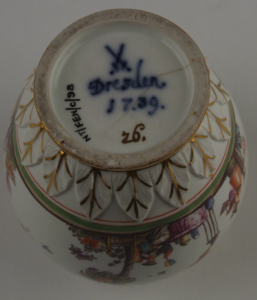
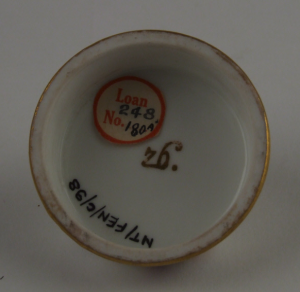
Important and Rare Augsburg decorated Meissen Teapot circa 1730 by Abraham Seuter modelled as a bearded Chinaman crouching on a scallop shell base, his helmet, which is surmounted by a frog facing forwards, forming the cover, the spout in the form of a dolphin held between his hands, a male and female satyr forming the handle, the body gilt with figures in oriental landscapes.
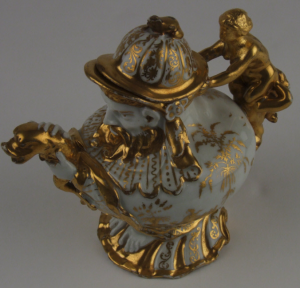
This rare group of a Cupid sitting on a Sphinx circa 1750 has a very indistinct cross swords mark seen as a smudge on the left side of bottom image.
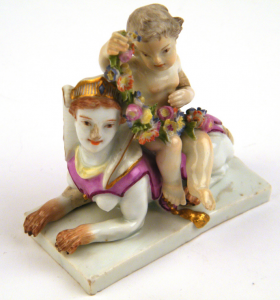
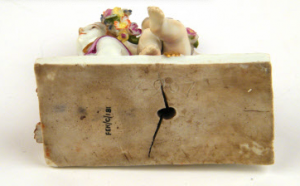
This charming little group of a hen and its chicks was modelled by Kaendler circa 1750 and measures about 10cm across. The blue crossed swords mark appears painted pale blue is another very good example of the huge variations of the cross swords mark.
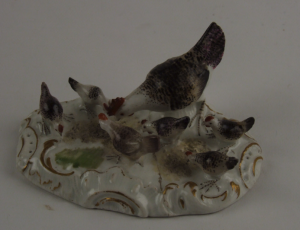
This very small figure of a turk measuring around 5cm high may have been part of a chess set made for the Turkish Market. Circa 1750.
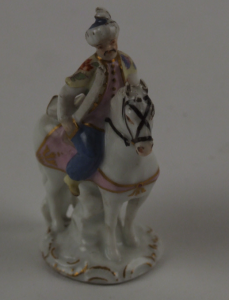
Florence Court County Fermanagh
The Marcolini period basket below dates from circa 1782 and is a new shape introduced that differs from the flowing borders of the Rococo period. The other noticeable feature is that the basket no longer has feet.
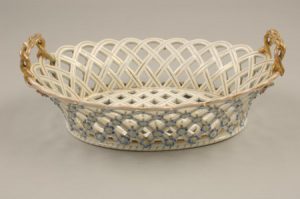
Florence Court County Fermanagh
Greenway Devon
Greenway is possibly unlikely any other stately home in the UK.
Greenway Torquay in Devon is unlike any other stately home in that is was Agatha Christie’s holiday home. At the bottom of the information about the Meissen in Agatha’s home is a link that tells you a story about her interest in collecting Porcelain. Although Meissen is mentioned the illustration have little to do with Meissen although the pictured vases were the most advertised as Meissen vases ever sold at auction at nearly have major auction salesroom around the world. This also included Phillips as Bonhams didn’t exist back then, Christies and Sotheby’s. Many of my competitor friends used to ‘laugh at how specialists back then(we are talking about pre-internet and only desktop computer days) made the mistake of believing the Meissen Schnneballen style vases were authentic Meissen. But in fact Samson Copies. Follow the following link to find out more about the Samson Copies or the link at the bottom of this section.
What I particularly appreciate about Agatha’s taste in collecting was that we shared a similar taste. While I did also buy 18th century European and English Porcelain I was also buying selling Imperial Chinese Wares and Japanese porcelain. This learning curve also helped me relate to many designs Meissen’s style was initiated from.
Nevertheless Many of the items in Agatha’s collection would never have been recognised as Meissen copies and probably sold as the ‘real thing’. Agatha on the other hand was not concerned whether a piece was genuine or a copy or a fake. It was the look of a piece and where it was placed in the setting of her home that interested her. You can learn more about the different reasons collectors buy Meissen but remember beauty is in the eye of the beholder and I can only begin to grasp the beauty that this famous author beheld.
The following image is of a ‘Schneeballen Style Vase and Cover. Compared to the original seen on this page; Had you not known what an authentic antique Schneeballen (Snowball design looked like you might be forgiven by the mistake). Of course there is a major difference. However because of the rarity of these Schnaballen Vases (the original Meissen is of a type far more complicated in design. Vases house a rather unusual concept within the vase’s interior. But not the interior of the actual vase. But in the base that supports the main section; a model of a bird sits in a cage.. Whereas the Samson Copy there is none. Dubious poorly painted crossed swords mark of ‘fake Marcolini period with a star beneath the pommels. Original Marcolini pieces the painting of the star would be painted away from the crossed swords pommels as opposed to squashed against the swords.
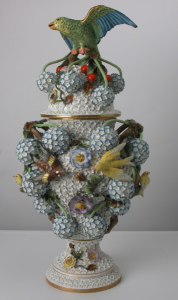
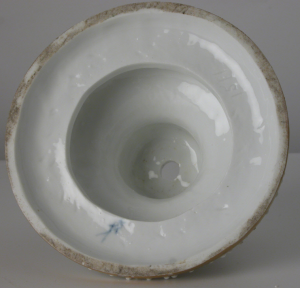
The following model of a Cherub sitting by a clock is a particular model not often seen as it doesn’t conform to the general design of much of Meissen’s designs for clock cases. There is also a good view of the mark and since the clock dates from circa 1870 by copying the mark and the other marks on the website you will be able to build a comprehensive list of genuine crossed swords marks and compare with the fake or copy trademarks.
About Damage and Restoration that may be seen on this type of Floral Encrusted workmanship seen on this clock.
While the clock case may look in marvellous condition I must say something about minor damage seen on floral encrustations. These occur; some pieces survive better than other’s while other pieces suffer many chips to the encrusted leaves and flowers. Such type of decoration is a restorers never ending restoration. The majority of restorers colour in the chips as opposed to making new petals or leaves that can become prohibitively expensive to replicate exactly(invisible restoration). On the type of piece where is seen so many floral encrustations it is acceptable for their to be minor chips to leaves and flowers. If your interest is in owning such a piece. Do not expect it to be in perfect condition. Be grateful if there is minimal damage or restoration. This type of damage will not devalue the worth of the item.
Typical Crossed swords mark circa 1870 is typical of the Leuteritz period.
Gunby Hall Lincolnshire
Possribly not the best examples of white glazed Meissen Figures circa 1850. Normally when Meissen painted in the white it is of sharper detail than this pair. However when the pair were modelled was during a ‘poor’ period of Meissen’s production. The middle of the 19th century was not good for the Meissen Management in terms of profitability as the premier porcelain maker struggled. White unglazed figures with classical design bases had already proved to be very popular when they were first introduced by Juchzer during the 1780’s. However the original examples differed from this pair since without glaze they appeared to be modelled in sharper detail. Possibly this is an illusion. Circa 1880 was the decade when Leuteritz was creating the finest quality models in both painting and modelling. Nevertheless what this pair do is to illustrate a good combination between authentic crossed swords marks on this pair of white glazed figures of a gardener and companion.
.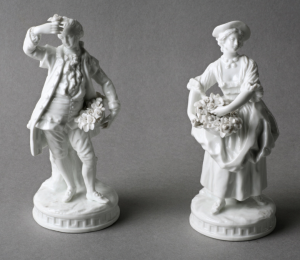
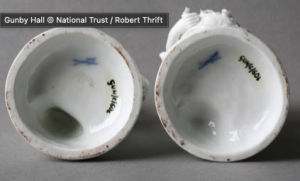
Hanbury Hall Worcestershire
A couple of years ago I had chance to find one of these complicated table ornaments at a bargain price and the next time one turned up at auction I was unable to buy it because of the competition. I was annoyed at the time that I didn’t try to bid a higher price; that is my regret.
What I find interesting is that this model appears to be amongst the more sought after in collections since it appears here in many different types of table decoration. It is so wonderful to see so many more objects belonging to the 19th century because ten years ago there was more interest in the 18th century. Go back 20 years and even common pieces of the 18th century were far more collectable than today. However today there has become more interest in table wares and 19th century figural wares of many different types of designs. I wonder how many more of these complicated encrusted table ornaments I’m going to find in the English Home since at Hanbury Hall I find two. I can only imagine they were amongst the most popular designs in the early part of the 19th century. Yet the design may have petered out as I am not away of the design appearing in the workshop of the great artistic director Leuteritz. Perhaps I will be eventually surprised. While I have bought and sold many thousands of designs throughout my career in the antiques trade this is one of the models that has rarely appeared through my hands while there are still a few models that I have never seen before.
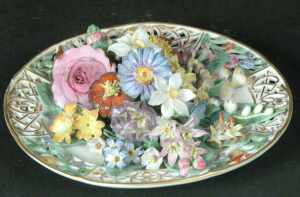
Compare the slight difference in form of these two table ornaments each around 25 cm Diameter dating from the early part of the 19th century.
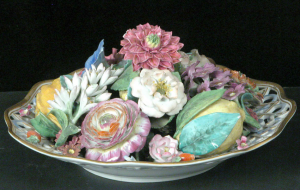
A useful way of understanding the differences of age of original modelling on Meissen is by being able to relate to the different colours of glazes that appears on porcelain. While glaze itself is invisible it is the pigments of colour from the layers of painting as to where the difference lies. All models made in the Marcolini period that extends from 1784 to 1814 suffer with a greyness to the glaze. It might be a good reason why they have never been so fashionable and can still be bought for a bargain price compared to brighter glazed pieces that date from circa 1860 onwards. Yet purchasing a figural group from this era you are purchasing the original model when it first hit the production lines.
When Count Camillio Marcloni took over as director of the Meissen factory his taste was for the paler type porcelain glazes that appear on porcelain manufactured while he was in charge. Once he had completed his term at the Factory there would be a lull in the mass production of models until 1840 when the desire was for more brightness to be emphasised in the colours seen on all models. Figural groups of this type date from circa 1780.
The group seen is of a man woman and child around a pastille burner. An interesting
While my comments about the style of painting on figural pieces may appear critical; the very subtle opposite can be said for the many visually striking cabinet cups, coffee cans that were made during the Marcolini period. I am not certain that there is more than one coffee can with this pattern. It will require further investigation to find out if the flag painted on the ship on the saucer is pertinent to a particular state country or family. The majority of these cabinet pieces are painted with a stylised decoration as can be seen on the side of the can and around the centre of the cartouche on the saucer; two blue lines with gilt wreathes.
One point I would like to make in regard to condition that is worthy to learn about if your interest is acquiring as perfect pieces as is possible. If you look at the top rim of the can you will notice some areas on the rim where the gilding is missing. This is because of general wear and tear that may have also been caused by cleaning inappropriately.
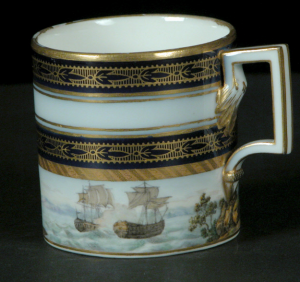
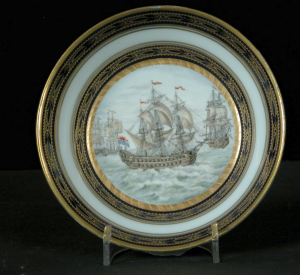
Hill Top Cumbria
Johann Gregorius Horoldt was the most important artist in the eighteenth century. Had they had a chance no doubt Kaendler would have loved to have had a pistol fight with Horoldt. Each had a talent that created the Meissen management to produce the finest painting Horoldt circa 1723 onwards and Kaendler 1730’s onwards. They both did not get on well together often fighting albeit never ending in bloodshed.
This quatrefoil bowl is a later example of the type of painting the Horoldt period workshop specialised in. The gilding brought in from the Bottger era from the major gold and silver smiths that were introduced to Meissen as early as 1718. This outstanding quality of the gold leaf painting added to the overall brilliance of every piece made. Much of Horodlt’s work can be found in the collection at Poleston Lacy seen on this page.
Hinton Ampner Hampshire
Some 35 year ago during the middle of the 1980’s I was commuting to the US to buy much of the stock of Meissen. The majority of the trips were to buy from the many antique shows that were on in virtually every major state Capital every week of the year. Back then I was doing my best to attend all of them. Sometimes this meant travelling from one state to another on the same day.
Periodically I was buying from the New York Salesrooms; Amongst my favourites were Christies East and Sothebys York Avenue. You’ve got to understand my visits to these salesroom’s was more luck than good judgement. More often than not I would turn up unannounced and ask to see what was coming up in future sales. On this occasion that was pertinent to my visit there was a general sale going on in one of their secondary sales. Low and behold I couldn’t believe my luck; three of these presentation tureens were in one lot in the sale with an estimate of $1,500 for all three. Bear in mind there was quite a bit of damage on all three with heads off and pieces out of the rim.
While there were New York ceramic dealers who would have been interested in the tureens it was the ‘poor condition’; from their perspective that put them off buying them. But there is also another reason. Amongst the finest antiques restorers; not just ceramics reside in the UK. While I don’t want to belittle those restorers work that I knew about who resided in the US there were none that I knew of who were capable of the type of standards I expected from my restorers.
The The three cost me well below what I new I could sell each of the tureens for. I think I paid $12,500 for all three and sold for £35,000 to one of my customers. A handsome profit even with the restoration that cost over a £1,000.
However if you wished to purchase one of these presentation tureens in today’s climate you would likely have to pay close to £35,000. If you wanted to buy from Meissen then add another 50% and probably have to back order and wait five years.
The finest quality of these presentation tureens would have been painted by August Ernst Leuteritz. Leuteritz created amongst the finest workmanship ever seen at Meissen. The date then would have been 1880. However the high standard that he ensured was in force at Meissen at the time was a necessary component to the management staying afloat. These were very challenging times for Meissen with the likes of Sevres in France who prided themselves with extraordinary achievements in quality with their porcelains. Then there was Minton who had crafted a new type of porcelain that was invented at Sevres known as Pate sur Pate. There will be a chapter all about Meissen’s Pate sur Pate coming in June where I will be shooting a short film about a fabulous pair of Crater Vases coming up for sale in July at Bonhams.
Meanwhile just feast your eyes on this tureen. In respect to understanding why there is damage seen; See chapter about taking care of your Meissen.
The damage to the head(lying on the table) is mostly likely to be have caused by carelessness. In the story about the tureens I owned there was much chipping and small pieces missing from the top rim. If you look at the quality of the interior gilding there would have been many layers of glaze painted onto the piece to make the gold appear very shiny and of the highest possible quality. Gilding is a restorers nightmare even for the most accomplished of restorers and this includes the Meissen factory. However the saying goes you get what you pay for.
The very best of the more accomplished restorers are ‘worth their weight in gold’. You would unlikely to be able to notice the differences is how good they are at their restoration jobs. However give the job to other restorers who do not have their cababilities and sadly there will be a noticeable difference even if you cannot directly see it. The other problem you will have inferior restoration does not last as long as the best quality. Even if you went along to the Meissen factory unless they have been able to obtain 150 year old gold dust to paint with; modern gilding will comes out a different colour.
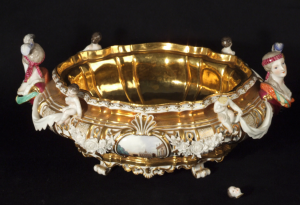
The crossed swords mark on the tureen is also a very good example of a mid 19th century trade mark. You can easily see the pommels on both ends of the handles that help authenticate the mark.
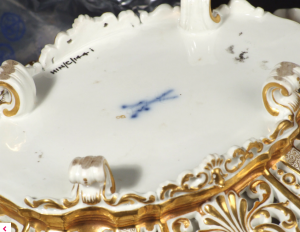
I personally would never house any piece of Meissen under a glass dome. However one advantage of doing so from a care perspective is that you will rarely have to clean the piece.
This clock on a stand stands 70cm tall decorated with encrusted flowers from the Mythological series of designs. It was originally modelled by a joint effort by Kaendler and Eberlain in 1743. A semi-clothed lady sits on top of a larger eagle underneath her. Below the clock-case is painted a Polish Shield.
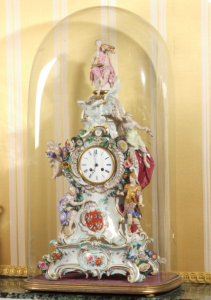
Japanese Kakiemon was considered to be the finest porcelain money could buy at the end of the 17th and beginning of the 18th century. If you could find two similar items; say for example the dish below; one Meissen the other Japanese the Meissen would be the finer painted. That is how it is. Why this is is perhaps the quality of hard paste porcelain and the types of pigments in the paste. Or perhaps it might have been the Meissen artist was doing his best to improve on the overall quality.
This Kakiemon plate is of a type that is more sparsely decorated than much of Meissen Kakiemon. However with Japanese porcelain a lot can be said about simplicity.
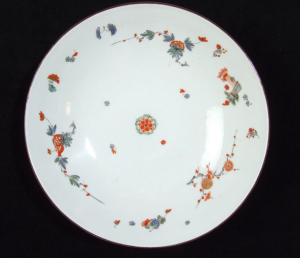
While I admire the majority of Ernst August Leuteritz work I cannot say the same for the design on this dish that measures around 31 cm diameter. In defence to the decoration Meissen had to cater for every type of taste that could be imagined. This gaudy design was of a new type that was emerging towards the end of the 19th century and well into the 20th. Gilt bouquets of flowers inside an ornate gilt rim surrounds a centre painting of a bouquet of fruit. Most often this form is seen just in two colours without the centre decoration; white and gold; blue and gold. Circa 1730
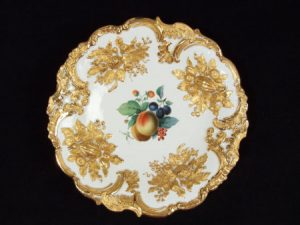
A Meissen saucer-dish, the centre with a fruit-spray, the border moulded and gilt with fruit and waved ornament, circa 1850
Hughenden Buckinghamshire
As a specialist in 19th century Meissen I admired both the small and intricate but also the fine quality large and spectacular. Often when I’m looking through my correspondence I come across an enquiry display a cabinet purporting to be Meissen. Sadly the majority of such enquires turn out to be Dresden Porcelain in the manner of Helena Wolfson where panels are inserted into the furniture with little hope of ever being able to see a cross swords identifying the panel as being Meissen. It is only the expert eye that can determine that. A closer look at the candlesticks in the lower of the two photos determines the porcelain on this piece of furniture to be Meissen made while Leuteritz was director.
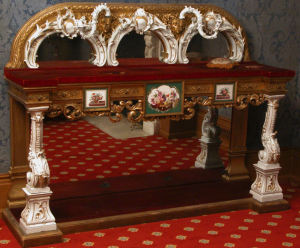
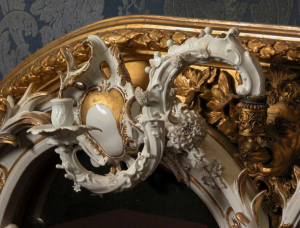
Ickworth Suffolk
During the early years of Meissen’s production the management at Meissen invited Augsburg silver and goldsmiths to decorate Bottger’s porcelain. The following fluted tea bowl and saucer was originally painted in white and then sent to Augsburg where the Goldsmith Bartholomaeus Seuter painted in gold.
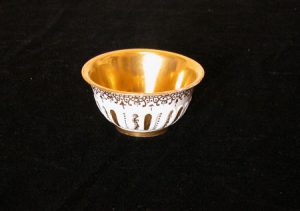
Figures painted in centre with gilt chinoiserie ‘Laub und Bandelwerk’. Gilt ground inside.
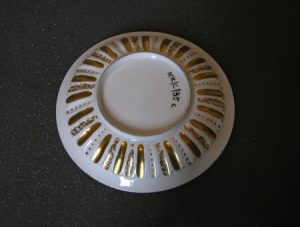
The rectangular tray below illustrates the difficulties that sometimes occurred with the firing of any piece. Be it figural, object of vase etc. any piece could shrink up to 30% while in the oven. There were never any guaranties any piece would come out perfect. This tray is an example of the imperfections that can occur. Circa 1770.
What I would also like to point out that the weakest point of any porcelain object is the handles. Most probably this tray was picked up by the handles hence the breakage. Learn how to take care of your possessions at:
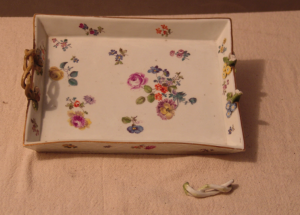
Kedleston Hall Derbyshire
Service wares produced in the middle of the 18th century can look quite spectacular when they were made for multiple placings. This tea and coffee service is quite incredible in that it includes amongst its wares some rarer objects such as a three footed water pot as well as coffee tea pot; bowls and cups and saucers. Shown in a sample of the set circa 1740-45.
When looking closely at any piece what makes it rarer than the more common is subject matter. I have not been able to inspect the pieces close up to see what they might be. Looking at the slop bowl it appears there is an injured man seated on a chair while a doctor is attending to his needs. A servant stands nearby holding a drape while the Doctors instruments lie on the table. As a single piece this bowl would be highly collectable by collectors of medical history.
However there is more to the service than meets the eye. It is doubtful that there is more than one service of this type.Comprising of 38 pieces; it is both a tea and coffee service painted with miners in wooded landscape vignettes, probably painted by B.G. Hauer after engravings by Christophe Weigel published in Nuremberg in 1721. The set comprises; one spoon tray, one pear-shaped hot water urn and cover, one hot milk jug and cover, one teapot and cover, one slop bowl, one arched rectangular tea-caddy and cover, five coffee cups, ten teacups sixteen saucers and one leaf shaped bowl and lid.
The following are a sample of the main pieces in the set; circa 1745.
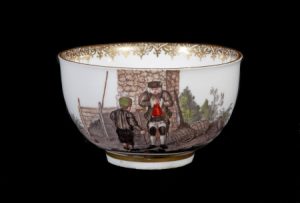
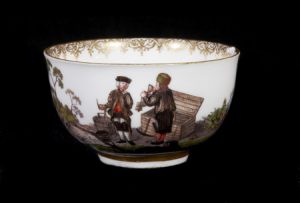
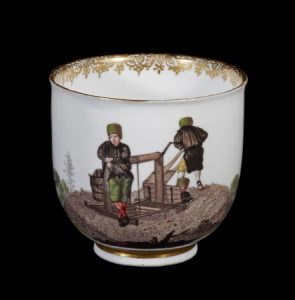
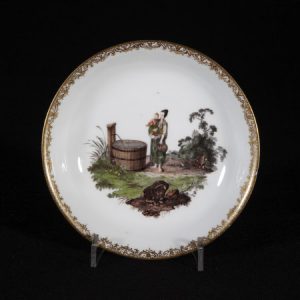
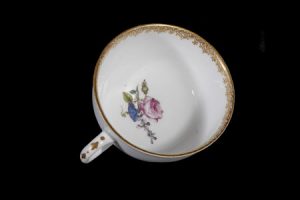
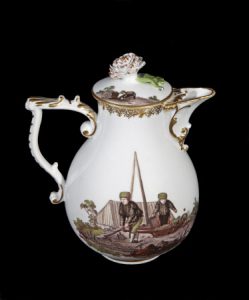
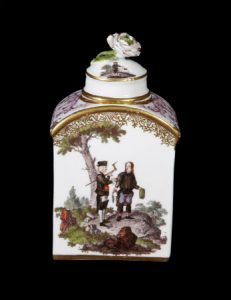
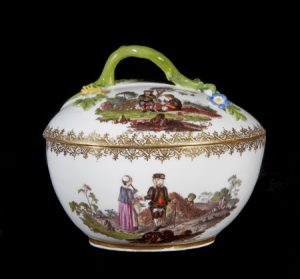
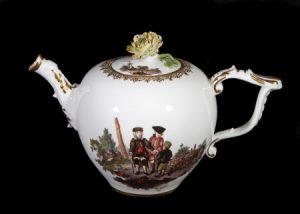
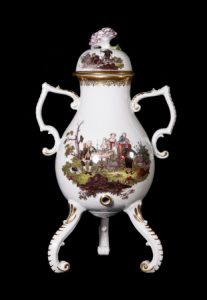
See below for typical crossed swords marks for the period of the above tea set. circa 1745
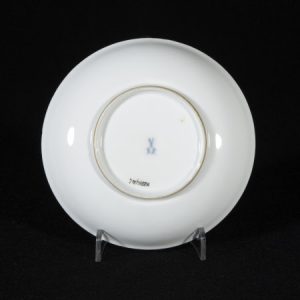
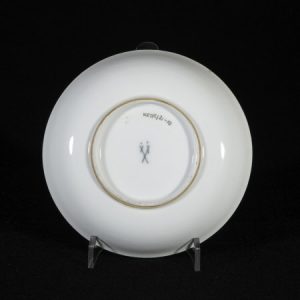
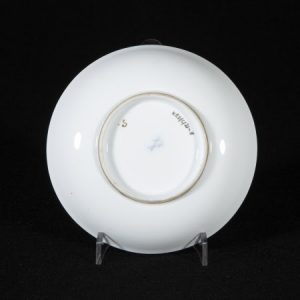
Kingston Lacy Dorset
During the 19th century after the industrial revolution the modelling department began experimenting with new shapes. The 19th century was met with new demands from a far larger customer base to satisfy the many fashions of porcelain making. Different shapes were experimented with. Many later similar family groups to this one would have been made on a wider base illustrating family life as opposed to a scene illustrating from front to reverse. The rather dull brown painted base tries to emulate a real floor but makes a poor job. The rococo border is towards the end of its life. The overall quality of this family group of a Mother tending to her daughter at a dressing table while their family cat sits by the daughter’s feet is typical in the style of the period if not the shape of the base. It was also a difficult period for Meissen when this piece was made circa 1860. The management were coming out of a difficult financial period as between 1830 and 1850 was a a lean period to making figures and groups.
Circa 1860 to which this group belongs illustrates an attempt to model better quality models. This family group is one of the rarer groups of the 19th century.
Amongst Kaendler’s many achievements was to introduce mythology into his creative talents. One of the most popular genres was; “Love”; to which Cupids would be included in the modelling. This charming small group some 15 cm across is of two cupids churning a love potion.
While the group was originally made in Kaendler’s era this particular model was modelled under the workshop of Leuteritz responsible for the better modelled and painted porcelain figures and groupings circa 1880. a date when the finest of the 19th century Meissen was produced.
Christian Gottlieb Juchzer was a modeller responsible for a change in the style from the earlier romantic era of the rococo style to a more classical design introduced in the late 1770’s. Juchtzer specialised amongst his achievements a new type of porcelain. That of what was to become known as biscuit porcelain(unglazed). The modelling of pieces in their basic white colouration appealed to the customer during this time.
This model was recreated in the workshops of the famous painter Leuteritz. The quality of the unglazed porcelain is second to none, very striking and stands out amongst the crowd if you could compare to similar items of lesser quality.
The subject matter on this group is one of the rarer models. It is very possible that lesser models survived as in today’s market place few of these types of unglazed groups are ever seen circa 1880 20cm across. This groups depicts a Mother sitting on her daughters rocking bed that in turn sits on a very classical looking base.
The five Senses as they are known are amongst the most sought out of collectable sets. However a common problem with these sets are that many were broken up and individual figures became separated from their respective circa genres and what is often seen is a huge variation in quality. between the earlier 19th century models made circa 1850-60 and those made in 1880.
However in the 1890’s because a new type of glaze was introduced the overall quality lessened. Other Senses exist in other houses and on the page about quality will be the different sense qualities side by side. The Senses was originally modelled by Johann Schonheit in 1772
The Sense of Sight circa 1870. A lady in pale-pink and yellow striped and flowering clothes, sitting before a dressing table looking in the mirror. The shaped rectangular base moulded with gilt gadroons.
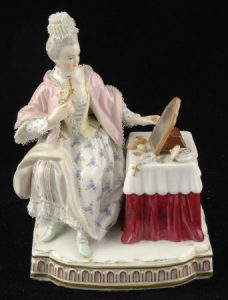
The Muff Lady dressed in a pink shawl, blue cape and striped and flowered dress, standing on a mound base with moulded gilt scrolls. Modelled originally by Michel Victa Acier 1777. A variation of the figure can be seen lace work that hangs over the sides of her head to which this figure does look like it did have. Amongst the problems with the lacework is that it is very delicate and is easily damaged at the slightest touch. The other problem is that very few examples exist without some form of damage to the lace work. From an aesthetic perspective it may look better if the figure is without the intricate lace-work(although it adds to the overall quality).
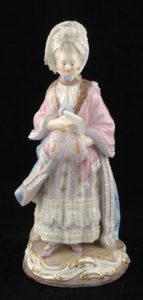
Knighthayes Court Devon
The ‘Deutsche tranier Blumen’ design of a colourful floral display at the centre surrounded by a bevelled moulded border was very much in fashion as being amongst the most popular Meissen designs for serving dinners circa 1765.
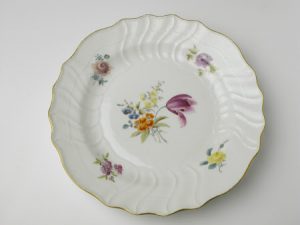
Looking at this crossed swords mark that dates 1760-70 it is therefore not surprising that copies are called authentic when there are so many slight variations away from the traditional crossed swords mark pertaining to the period. IN this example the swords is supposed to be painted in a recognisable shade of blue but actually looks more grey in appearance.
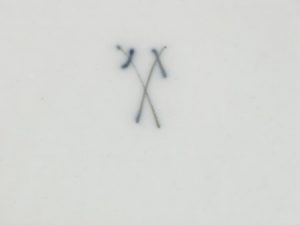
Lacock Wiltshire
In England the shape of this jug is called; “sparrow beak”. However the moulded jug is Meissen; sadly with a missing handle that has been recreated in metal and covered with wicker.
Nevertheless putting the damage to one side it is a wonderful example of some of the delicate artistry that was in place at Meissen with some of the early paintings in the Kakiemon style circa 1730 . Notice a blue star on the foot rim. Sometimes flower painting was used to cover up imperfections in the glaze.
Mid 18th century vase of baluster shape on a moulded shell pattern.
I am a specialist with a varied taste. Depending on the object and where it might be situated I enjoy the most complex of pieces. But I also revel in simplicity to which this small vase about 20 cm high is. A beautiful painted rose sits on the top of a bouquet of flowers. The neck is similarly floral decorated. Handles are of a crab stock design circa 1760

Lamb House Kent
It always disappoints me when an object is described as Meissen but clearly is not. The ornithological painting was first introduced circa 1765 at Meissen.
Had the cross had two handles at the end of the cross on the mark then I would have excused them from mistaking for 18th century Meissen. However so many novice collectors, administrators and sellers make this same mistake. Most probably it is a Dresden copy that dates around the end of the 19th century. assuming both mark and piece are period Meissen.
Looking at the ‘wine cooler’s shape in more detail by carefully inspecting the interior close to the top rim is a rough surface permeating around the top often when you see this on pieces; this means a lid accompanies the cooler.
Lanhydrock Cornwall
Leuteritz was responsible for the finest workmanship ever seen at Meissen. The period when Meissen porcelain began excelling in modelling occurred in 1880. However, Leuteritz first established his relationship with Meissen when he began working at the factory around 1840. Just like Kaendler crafted incredible talent Leuteritz inspired the management to eventually make his a director of the modelling and painting department. Leuteritz was responsible for recreating styles in the image of Kaendler’s rococo workmanship adding his own uniqueness.
It was the norm in the majority of family groups to have a boy or girl playing a musical instrument as it is the norm to see a cherub(seminude or nude boy)sitting on a goat. This group standing 35cm high. Observe the very rococo border surrounding the base; circa 1860.
Melford Hall Suffolk
There has always been two genres of thought as to what Meissen Porcelain would be used for. In the beginning of the 18th century and for the first fifty years of production the majority of pieces was used as decoration. Even Count Bruhl’s unimaginable dinner service comprising of more than 2,200 piece was meant for show and not to be used as was virtually all the other pieces made. However after the seven years war when the Russians invaded Saxony and took over the Meissen Factory the management realised they needed to bring in additional income. From this period onwards they began marketing dinner and tea services to be used at the dinning room table. The pattern on this tureen that dates from circa 1765 is typical of the patterns seen and is still replicated today. More often than not a figure of a boy or girl replaces the tureen covers knob.
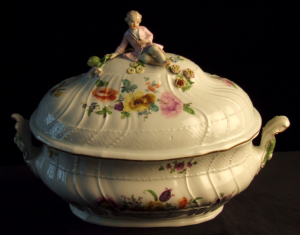
Mompesson House Wilts
Of all of the ornithological models Meissen produced cockatoos and parrots are the most sought after. The cockatoo illustrated here dates from circa 1890, ten years after Leuteritz created the finest quality of workmanship every found at Meissen. However towards the end of the century the Management were looking at new types of glazes that could be more easily produced for a growing audience of customer to compete with other English and European factories who were increasing in numbers and trying to make life difficult for the survival of the Meissen factory. A new type of white porcelain glaze was produced.
No doubt during this period a new production line may have been necessary for commercial reasons. As a Meissen specialist I have found the whiteness in the glaze has taken away some of the quality of modelling and painting found ten years earlier where there was so much more expression even on the smallest parts of a figure. The detail on this cockatoo would have been much sharper in both modelling and painting.
Even so in my opinion other than the Pfeiffer Period in the 20th century between 1924 and 34 when a return to exceptional workmanship that equalled some of Leuteritz work even this late 19th century Cockatoo is striking to look at. 32 cm high.
Montacute House Somerset
It is somewhat difficult to imagine this elaborate barbers bowl would actually be used to be smothered with beard droppings. I hope this was not the case although it wouldn’t surprise me if it was occasionally used as such. Most of these well decorated dishes were rarely used. More-so seen as table decoration and in the case of this shaving bowl also for amusement.
These shaving bowls were copied from Chinese and Japanese first produced in the late 17th century. In China during the Kang Hsi period and in Japan mostly in Imari and Arita.
The Meissen oval shaving dish illustrated below, with notched rim, white painted with scattered flower sprays and reserves of figures at sea ports in the style of Herold within shaped oval borders of pierced gilt scroll work. Crossed swords mark in blue. Circa 1745. Cracked in two and rim repaired. With morocco travelling case to fit.
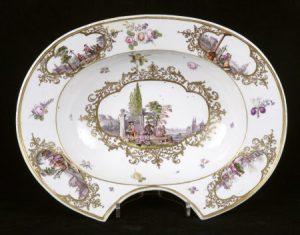
Mount Stuart County Down
Not all the great houses have great collections of Meissen. However those that don’t sometimes have something that is a little different from the rest. This is the case of this charming art nouveau group of Two Foxes circa 1920.
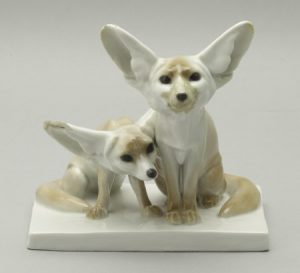
Nostell Priory, West Yorkshire
The group of the Decisive Choice below is one of a pair modelled by Schoenheit 1787. This model dates circa 1860. A notable feature that is found on the majority of figures and groups is facial expression(not dissimilar to you or me having our passport photos taken). Rarely does the expression smile or laugh. Here, a decision is in the making by a mother who is disappointing her children. However is something wrong with this group; what do you think; do you notice something strange?
Okay I will let you off this time. This group has a number of faults that you can only recognise by either turning the piece upside down or looking at lower image illustrating the crossed swords mark. L
Looking closely at the crossed swords mark just above the pommels on the handles are three incised lines. This means; “cancelled crossed swords”. But what does this actually mean. Whenever a crossed swords mark has any cancellations across or beside the mark this means in general there are faults on the piece. In many cases if there is just one of these incised lines or others painted in blue it can be quite difficult to determine exactly what the faults are. On this group it is a little easier. There is another giveaway sign in the form of an incised triangle that sits below the crossed swords. Models that have this mark were painted in the white. Therefore this group would have most probably been sold in the white to another porcelain artist who has reworked the piece. However look further to the left and there appears some restoration that was hiding the firing crack that can be seen. Therefore the modelling department might have decided to add extra incisions. Click on the following link to learn more about the cancelled crossed swords mark.
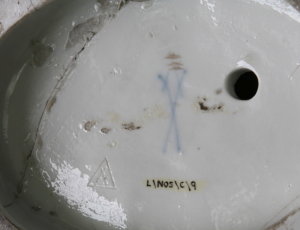
Nostell Priory, West Yorkshire
Nunnington Hall North Yorkshire
I have yet to go to Nunnington Hall although I have been to many National Trust and other stately homes. I’m most certainly looking forward to when the opportunity to visit arises. While my heart might miss a beat because I can get so emotionally involved when handling or even looking at a rare or great piece of Meissen, the age inconsequential. It is in the room settings of the great houses where I like to see how the porcelain is displayed.
For me Nunnington Hall’s collection stands out amongst the crowd in so much that they have a good selection of 19th century and later Meissen as well as the 18th century.
The first item on my list is this pair of Marcolini Period Cases and covers. It is a shape well known to me. I just love the manner in which the ornate lids sit on the blaster bodies of this pair of vases. Well painted on white grounds with rectangular scroll handles on rectangular bases is pretty much what Marcolini design is all about.
This pair will have a crossed swords mark with a star below the pommels of the handles denoting their identifying their age circa 1882.
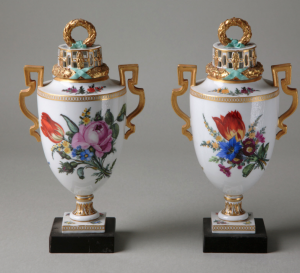
The The Baker-Boy carrying a tray of bread is one of the “Cries of Paris’ series originally by Kaendler circa 1756. This model was modelled by the Leuteritz workshop circa 1880. Leuteritz was responsible for the highest quality of workmanship found on the majority of pieces while he was director of the modelling and artistry departments at Meissen. A close up view of his workmanship is evident in not just the modelling but the painting. Its not just about the modelling of the clothing the baker is wearing. Look at his facial expression, the rosy colour of his cheeks. Look at the tray of bread and the bottle on the tray. Extra effort makes possible greater detail than you will find on any other models either from earlier of later periods.
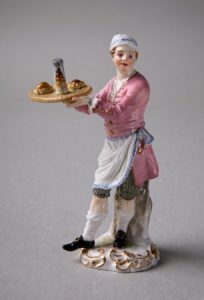
The model of a egg and poultry seller appears to have been made at the same time as Leuteritz workshop modelled their figures. However it was made just a few years later when Meissen was going through a transition period that is evident looking at the whiteness of the glaze on the base below his knees. While the facial expression still retains definition it is the overall whiteness of the porcelain that defines the figure’s age.
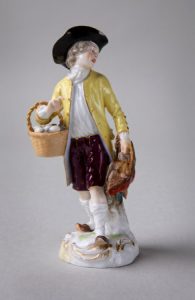
The Sense of Taste sees a Lady sitting next to a table, she feeding herself food and drinking from a cup of wine poured from a bottle. The rosiness of her face and the quality of painting determines this model was made in the Leuteritz workshop circa 1880.
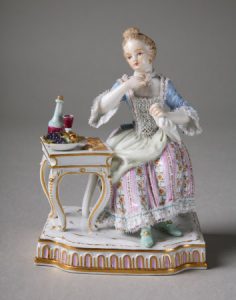
Without inspecting the crossed swords mark to the base it is difficult to establish the date of this Sense of Smell. However the base colour is very white. The majority of 20th century Meissen is very white as the base colour. Looking at her facial expression, she lacks the finesse of the quality seen in the later 19th century from 1860 onwards. It is very possible that this figure dates from between the first and second world war or even later. Until I can physically inspect the figure I will have to give the benefit of the doubt and say it is circa 1910. From 1934 onward the shape of the swords changed to curved blades. Compare other Senses by selecting the following link
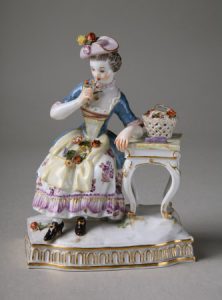
The yellow dragon pattern became very popular towards the end of the 19th century as did creating different colour variations for the traditional blue and white Onion Pattern. The example below painted in magenta on these two cups and saucers circa 1900.
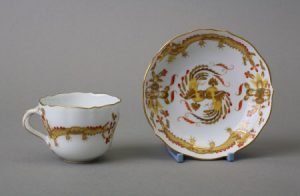
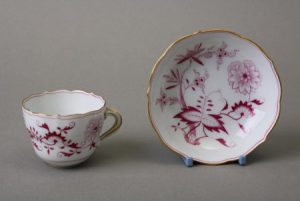
Nunnington Hall North Yorkshire
Osterley house London
The following two dinner plates are from the Earl of Jersey circa 1735. The painting surrounding the centre scene painted with Japanese Kakiemon type flowers.
Here’s another question for you. Here are two identical aged plates that belong to the same service. If you had to chose one which would it be and why. There are actually 21 plates in the service but these are two of the best ones I picked out.
Perhaps you like the decoration on the top plate compared to the bottom or perhaps not.
Let’s talk about condition. You will look at them and tell me they are both identical as far as you can see. Perhaps the bottom plate has more blemishes on the rim of the plate. What if I told you there was more serious damage that you can actually see; would you know what I am talking about?
All the plates in the service including this two have suffered from wear and tear. If you look closely on the top plate at the 3 o’clock position you will notice a small white patch in the middle of the green. This is what can occur to some pieces the glaze can get worn and paint can flake away. The piece as a whole may not have damage in the normal form of a crack or chip but there are other types of damage. See the page about watching out for unseen damages
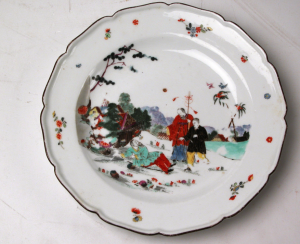

Peckover House, Cambridgeshire
The period between 1820 and 1850 at Meissen was a poor period of production where there was little evidence of quality pieces being modelled. This vase was made from this period. It might have been too that a new experimental colour had been introduced the purple lustre type effect seen around the bottom of the neck of the blaster portion of the vase. In one way the vase looks over the top. In another way it could have been better presented had it been gilded. Even so that this may be the only Meissen object on show in the house is better than none.
The purpose of this list of Meissen in the English home is to identify with as much Meissen seen in the National Trust so that people from everywhere round the country can visit when the opportunity arises.
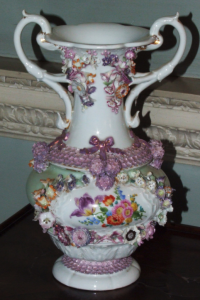
Peckover House, Cambridgeshire
Polesden Lacey Surrey
One of the joys as a specialist antique dealer living in London is having the facility of walking into Bonhams, Christies and Sothebys and handling great objects of works of art. Handling a Bottger tea caddy, Horoldt coffee pot or the rarest of Italian Comedy groups. It is the emotional attachment to being in awe of the workmanship that has gone into the making of a major work of art when you are holding a piece in your hand. This is another reason some pieces of Meissen fetch enormous amounts of money. Bidders at auction get excited by other bidders. However, this was how it used to be. Even during those days gone past there would be agents in the room bidding for customers overseas. Their customers didn’t need to have a piece in their hand. They would have a condition report and hope to own it. It is the emotional joy of building a great collection and being able to admire, touch and use every emotion available is the reason why great collections are built by the major collectors.
It is another reason the great houses of the wealthy of the last two centuries built up important collections full of the great rarities. Often when I am walking around stately homes I chat to retired volunteers and I explain more about some of the items I understand whereas they just enjoy the atmosphere of looking after the collections and hopefully get fulfilment for doing so.
Some of these homes not including all have great rarities in Meissen Porcelain. Polesden Lacey in such a house if your interest is seen great pieces of Johann Gregorius Horoldt. The following pieces are a sample of their collection.
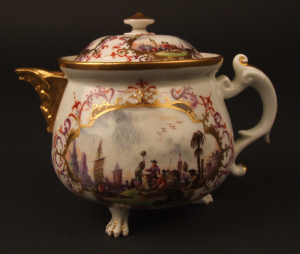
Horoldt had a growing reputation for painting scenes of Choiserie similar to the rectangular below.
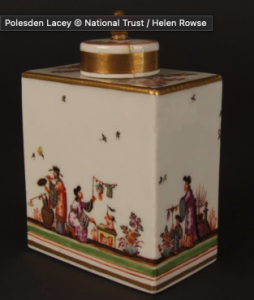
Horoldt also tried to emulate the stories that Chinese porcelain beheld. European painting of Chinese inspired characters going about the daily routine. Some can be defined a theatrical characters.
The decoration on the slop bowl below illustrated a crouched Chinaman appearing to balance a parrot sitting on a stand on his outstretched hand. Behind him scholar is handing a bag to a child. An elaborate script style in gilt surrounds the rim. circa 1730
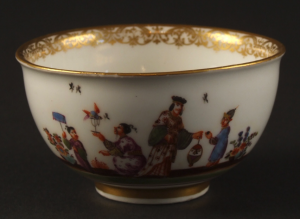
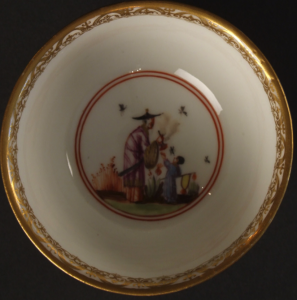
A similar slop bowl illustrates a man bending over holding a heavy bag while he has what appears to be a musical instrument over hanging over his shoulders. To his right two other scholars, one of which is crouching looking after a child who is wanting to take whatever is on offering. Behind by a fence stands a boy with a large fan.
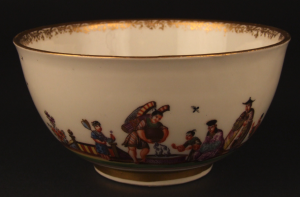
An octagonal dish illustrating a woman and a man under a palm tree. The man appears to have a rod hanging a bell. The centre cartouche is surrounded by a double red ring.
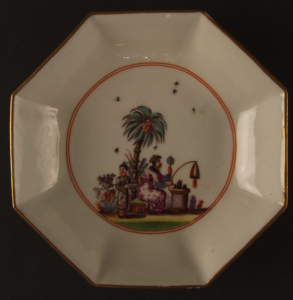
In China in was common to carry nobility on large chariot type chairs with four handles two at the front and another two at the rear. It was expected of servants to carry their masters. Hot water pots like this often had wooden handles.
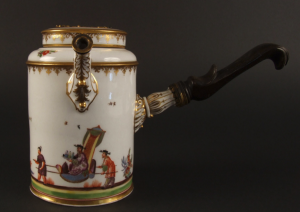
A battle is in progress as a horse rears up so its master can chop down with his sword. The only main differences between this covered yellow ground jug and the one above is ten year this one being made circa 1740 and the former 1730.
Possibly the prized piece out of the tea set at Polesdon is this splendid coffee pot with two chinese women serving tea.
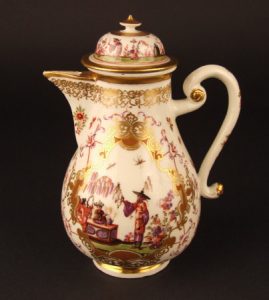
A Meissen porcelain coffee pot and cover, with Chinoiserie decoration in the manner of J.G. Herold.
When you begin to understand the painting in the decoration between 1720 and 40 you can begin to appreciate the talents of artists painting under the watchful eye of Horoldt.
This shade of blue is another of the ground colours found on Meissen porcelain of this era. Handles and spout of this coffee pot richly decorated in gold leaf.
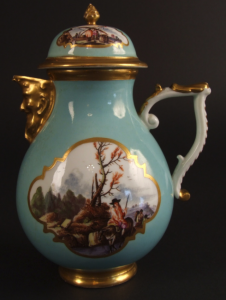
What I like about the collections of Meissen at some of the collections in Stately Homes are when there is the appreciation of the huge variety of models. This can be seen in the form of different types of service and figural wares taken from the first half of the 18th century.
The following figure is one of many from the Criers series of Paris, London and Saint Petersburg. Criers were basically tradespeople and artisans. circa 1756 by Kaendler. This model is of a Meissen figure of a vendor, selling buckles and earrings. Modelled by Kaendler (Kandler) and Reinicke from the Cris de Paris after Bouchardon. About 1755.
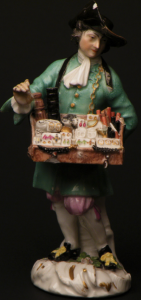
Another feature I like to see more of and over the last ten years most certainly collections are including later pieces. In this instance these are items that were modelled in the 19th century and later. As a specialist in 19th century I have always been saddened by the lack of interest or understanding of 19th century. The reason being is that the majority of the more well known pieces of Meissen that sit in the great museums of the world were all made before the beginning of the Industrial Revolution. Any porcelain made after this time was considered not collectable because items did not have a scholarly interest and were copies of 18th century examples and not originals.
The following group represents one of the patrons of the arts; “Architecture” model no 6. Three cupids building a column modelled by Leuteritz circa 1870. The modelled by Acier.
Acier was an artist who introduced change. Gone was the flowing borders introduced in the Kaendler era and replaced by scrolling borders with wreathes from circa 1770 onwards.
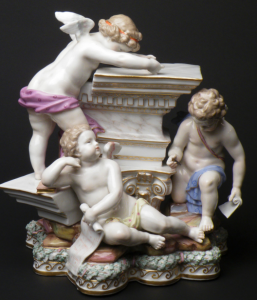
The Meissen scent bottle of a man holding a dog are rarely seen in fine quality. This model dates from circa 1840. A period when the factory was doing its best to come out of a period of industrial decline. Scent bottles are amongst the rarer objects produced at Meissen.
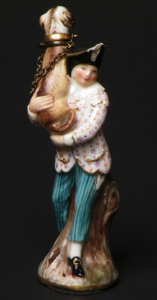
The figure below is a rare figure modelled by Kaendler circa 1745 illustrating an Italian Comedy figure of a Quack Doctor by Peter Reinicke circa 1755.

Plas Yn Rhiw, Gwynedd
Change in fashion is also what I like to see in homes. While the majority of the major collectors of the 18th century are in Europe USA and Japan. There is a new type of collector whose focus is on the 19th century since the 19th century is more easily understood than the 18th century. Even though the majority of figural pieces originated from the Kaendler period.
This pair of figural salts are from the second half of the 19th century. They differ from conventional salts in that they are holding shells on their laps as opposed to sitting next to baskets. Each figure represents wine making holding grapes in their hands. circa 1870.
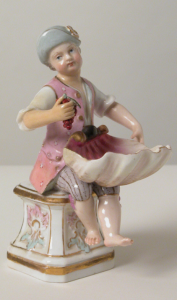
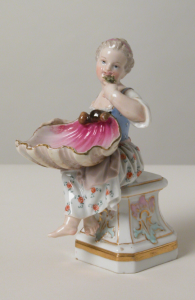
Saltram Cornwall
Horoldt also known as Herold was very creative as to the subject matter he painted on his pieces. This is evident in the following oval sugar box and cover. The decoration on the lid offers the best story. A Chinaman and his child are doing a man smoking a pipe while he sips tea. Circa 1825.

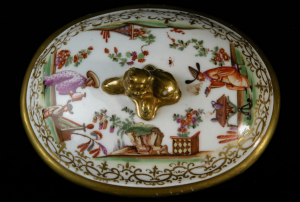
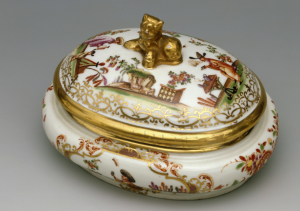
Scotney Castle Kent
This leaf shape handled bowl is an example of the earliest cancelled crossed swords mark seen on Meissen Porcelain. The majority of cancellations of Meissen Porcelain is seen in the 19th and 20th century but rarely during the 18th century. Particularly on marked pieces that show the Punct Period also known as the Dot Period ( circa 1760-65). A period where the modeller Punct modelled much work.
However he would have originally modelled this piece in the white as the green pigment in this green palatte
Seaton Delaval Northumberland
It is wonderful to find rare pieces of early 18th century Meissen where there is both an illustration of the piece and the crossed swords marks. On this part service this is the case. Here are sample images each painted with reserves of harbour scenes with laub-und-bandelwerk border incorporating Bottger-lustre.
While Bottger died in 1719 his porcelain was used until the 1730’s to decorate pieces.
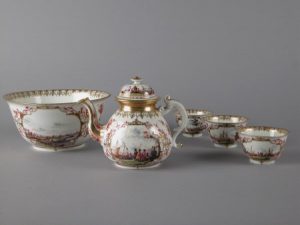
From the above part service see the following items for images of piece and trade mark.
Meissen teapot and cover, painted with harbour scenes.
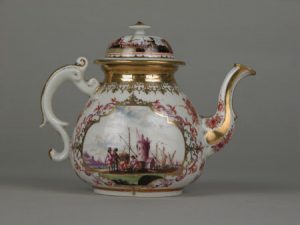
Meissen crossed swords trade mark as it appears on tea pot above.
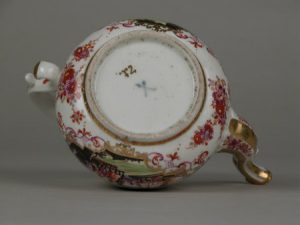
Front and reverse views of teapot lid.
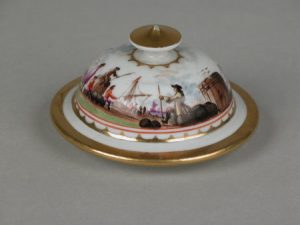
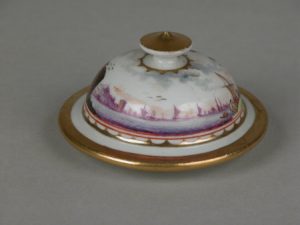
Slop Bowl Exterior View
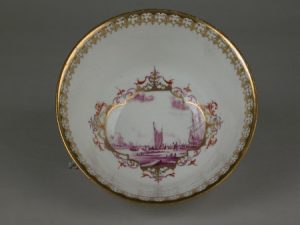
Slop Bowl Interior View
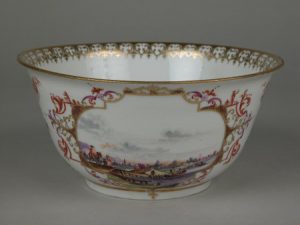
Slop Bowl Crossed Swords Mark

The following two tea bowls belong to the part-service. However you may notice something unusual about the bottom image; it’s missing the crossed swords mark. So how can you identify with the other pieces in the service. If you look at the marked pieces you will see painted in gold the artist no R2. The unmarked tea bowl has the same mark. This means the tea bowl was painted by the same artist and it identifies belonging to the service.
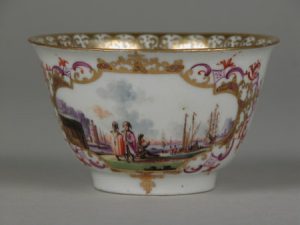
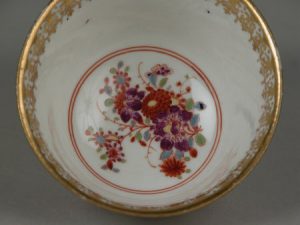
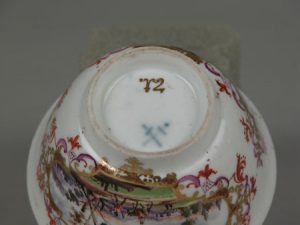
Teabowl missing crossed swords but recognisable as belonging to same service by the gold R2 painters no.

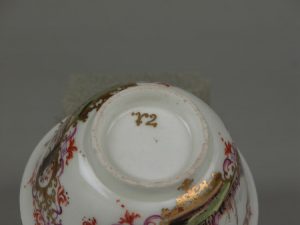
While the above items are from the early part of the 18th century the Ornithological figure of an Owl perched on a tree stump about 32 cm high belongs in the 2nd half of the 19th century circa 1870. The dark brown tree stump illustrates the period the owl would have been modelled to 1870. Another classy modelling work by Leuteritz. The mark to the centre is a very good example of a well painted crossed swords pertinent to models made during the 2nd half of the 191th. Model No L56 incised into base.
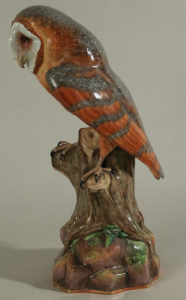
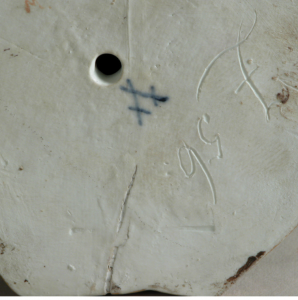
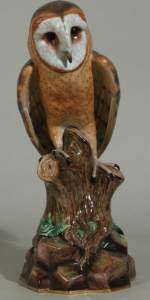
Shugborough Staffordshire
Find a pair of original Shneeballen models by Kaendler and it would be like winning the lottery. I was fortunate to have a similar pair to these ewers approximately 75cm high. This was back in the 1990’s. There is a little story attached to them. This was at the height of the epitome of the 19th century Meissen market and bought them in the USA at a cost of $65,000 when the pound was worth about two dollars. I sold them for £85,000. The last time a single came up for sale; I think it might have been at Sothebys I watched a colleague pay around £45,000 plus the buyers premium for a single example. The pair of ewers are amongst the most spectacular of Leuteritz quality of workmanship. The pair deserve being at Shugborough in that the Shugborough estate north of Birmingham in the midlands is amongst the more spectacular houses in the UK.

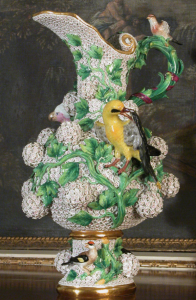
Snuff Boxes were amongst the most desirable objects Meissen first made in the middle of the 18th century circa 1750. Every part of the box was mostly used for artistic decoration. This meant not only the front sides but the reverse; the lid; the base and the interior of the lid. While the interior of the base is mostly of white glaze occasionally it can be found gilded.
While the bottom of the two snuff boxes is the more decorative and colourful the top snuff box is the rarer of the two. This is because of the subject matter. “The Pug Dog”; seen napping on he cover and characterised on the sides walking upright in a landscape. The interior sees the pug dog holding its cushion in front of his master. It is also possible the mounts are in gold as opposed to silver gilt.
It is not uncommon to see a painting of three goats painted on the lid and sides of this oval silver mounted snuff box. Surprise; surprise when you get to lift the lid and see the striking colourful painting under the lid of two lovers embracing. Her resting his head on her left breast. The goats painted on the lid are seen behind. The interior of the base painted in rich gilt. The underneath of the base decorated with the three goats shows it’s been used a lot. Much wear and tear is evident particularly around the top of the edges. The box does appear to have a small crack on its left side. These boxes generally measured around 8-9 cm across.
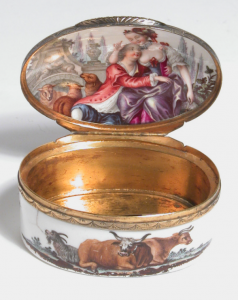
Sizerg Castle
The 19th century produced many diverse types of fashion. With many other European factories producing their own style in the image of Meissen. Meissen too was in competition to produce copies of other factories styles since as far as they were concerned their quality far outweighed the majority of their competitors. Frankly it did and this is not written from a bias perspective. Few Factories could compete.
However the raised porcelain on top of porcelain style at Capo di Monte was very popular as was the style of decoration of Chinoiserie. Meissen did their best to emulate the style with their own productions. This box was made circa 1870.
As a specialist in 19th century Meissen I have bought and sold object as small as 5cm high to as large as 160cm high and I have probably handled as much as several thousand different models. However, there are still some that have eluded me. However my main goal that was portrayed in the Meissen Collectors Catalogue published by Antique Collectors Club was to emphasise the finest quality Meissen modelled in the 19th century as well as find the original models catalogued in the 18th century with their sizes and details of who modelled or painted and the date first made.
Whenever I see the finest quality of modelling of pieces that Leuteritz personally had a hand in modelling and painting these are pieces that are perfectly exceptional in every sense of their description. Such pieces will command a far higher price than lesser quality pieces made just a few years earlier. It is inevitable that it takes many years of handling experience to recognise the qualities of Leuteritz workmanship.
The group of lovers below is a very good example of the breath taking achievement Leuteritz attained. Watch out for future videos as I explain in greater detail how to recognise the very finest of Leuteritz work.
Looking at the group from the top down to the very bottom the smallest of detail is finely painted in. Every strand of hair on the lovers, muscles in their arms and legs and even the contours of their veins. The sharpness of detail is seen on the lamb the lady is patting. The beautiful vibrant artwork of the cloak he is wearing; the dress she is wearing, the individual flowers sitting in his hat and the rose in his handed the sandals on his feet. The sharpness of detail is almost beyond exceptional. This is Leuteritz at his very best. Model after Francois Boucher. Follow the following link to understand the different quality found on 19th century Meissen.

blue crossed swords under glaze; painted red mark, ’53’; inscribed mark, ‘A 41.’; impressed mark, ‘III’;
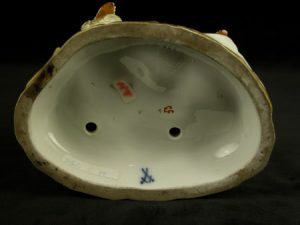
Springhill Londonerry
The very damaged teapoy and cover and the milk jug and cover are not Meissen but made in China in the middle of the 18th century. The interesting part of the story is the decoration seen in the cartouches are after Meissen Original painting.
Chinese export of this era just at the beginning of the Chin Lung Period circa 1750 is very rare but does occasionally come up at auction. It is also useful to see the differences in the making, the painting to compare with the hard paste of Meissen that is so similar.

Sudbury Hall, Derbyshire
Of all the many models of vases as well as service wares; Schneeballen decoration was considered one of the more complicated models originally recorded as first being modelled by Kaendler in 1740.
A series of schneeballen vases was ordered in 1761 for Frederick II the Great of Prussia, now retained in the Neues Palais, Potsdam. The fashion was revived in the 19th century in the workshop of Leuteritz.
This model is normally seen as a pair and comes in three sizes the largest of which measures approximately one metre in height.
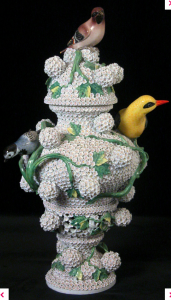
The-Argory County Armagh
I have already mentioned my specialism as being that of later 19th century Meissen Porcelain. Particularly the work of August Ernst Leuteritz who delivered the highest possible quality of modelling and painting ever seen at the Messen Factory during the second half of the 19th century. The two cupids seen below the circular dish and tureen are amongst the finest quality of the late 19th century.
Move back in time nearly 130 years before and you are confronted by the greatest painter the Meissen Management employed. His name was Johann Gregorius Horoldt. He was responsible for introducing new colours into the painting on Meissen porcelain in the early 1720’s. Without his input it is questionable whether the factory would have survived.
The circular dish illustrated below is a very good example of his workmanship. The minute rectangular cartouches of chinoiserie on the outer rim surrounding an intensely gilded interior surrounding a multicolour ball on a red ground.
While this dish is not unique and another reason its a good talking point is its condition. One of the problems of wear and tear on pieces that have much gilding is that the gilding can wear off in time. This can be caused by a number of reasons. Handling innapropriately, placing a tureen or other object on top and it rubs against the surface or it has been scrubbed clean too harshly. If you look closely to the inner border you can see that two opposite diagonal parts have much rubbing. A collector who was looking for a perfect piece would not be interested in this dish. Follow this link to see how you can avoid wear and tear on any piece you might own that might be vulnerable.

The dish above may have also been the under dish for the tureen below.
These two cupids are from a series of 26 figures by Schwabe and possibly aided by Polluck circa 1888. The modelling seen on each of these figures is of the best quality when the focus was of closest to natural skin colour and facial expression is was possible. Even the strands of hair are finely produced and painted in. The whole series is model no L1010-L126. These figure on the left is model no L106. The model on the right is an additional model that was possibly made for order but does not appear to belong to the set of 26.
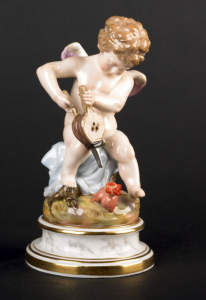
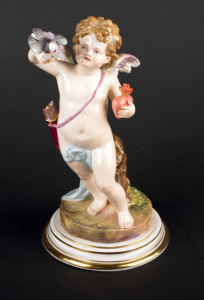
The Vyne Hampshire
The Sleeping lady or lady aslee; Model no G58 is a well known model that appears from time to time. This model is another very good example of painting at a time when Meissen ran into financial woes during the 2nd quarter of the 19th century. The quality here can be easily recognised when compared to models made after 1860. Both the chair she is leaning on and the base would be painted in white with some gilt added. It would be possible to see individual strands of her hair that is not so easily recognised. Surprisingly the crossed swords mark is well painted for this period.
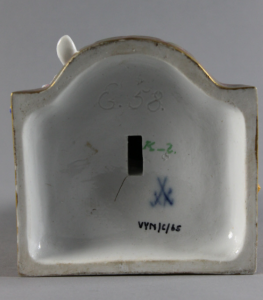
Tintinhull House Somerset
Tyntesfield North Somerset
Wallington Hall Northumberland
You would think the further you get away from London the less the chance of seeing quality and rare 18th century Meissen. Wallington Hall in Northumberland is an exception in that the collection houses some interesting and rare examples of early 18th century.
Pair of very fine beakers, with covers, with moulded acanthus leaves rising from the base and being moulded onto the covers. The beakers are painted with quatrefoil panels with gallant scenes in river landscapes, showing palaces and a nearby harbour circa 1725-28
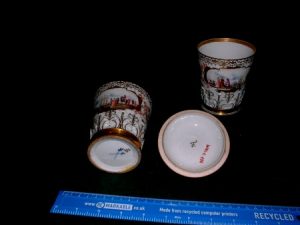
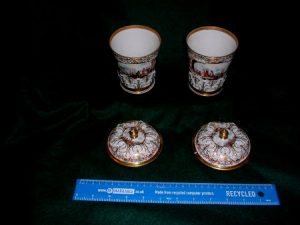
The pair of Cache Pots each with a bearded head below date from circa 1750
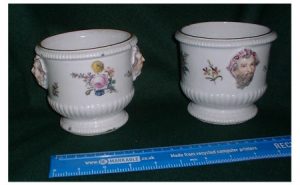
The floral Dinner Plate below is circa 1750 and was most probably used since only the plainest of patterns was generally used at the dinning room table.
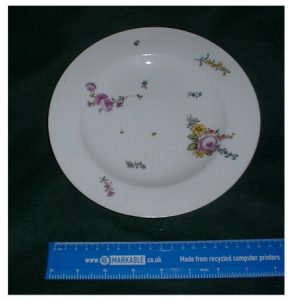
Looking at the following two cups and saucers each both from the Marcolini period each with similar decoration but with different handles. Its not surprising it is difficult to recognise the date of pieces by the marks alone given there are so many variations of the mark. Not that the crossed swords mark was intended to vary. The problem was the manner in which the artist painted the crossed swords was why no two crossed swords marks are completely identical.
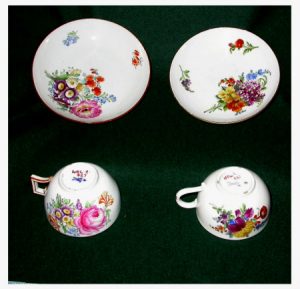
Wallington Hall Northumberland
Wightwick Manor West Midlands
Wimpole Cambridgeshire
I have often wondered why so much of Meissen figural sculptures the men and women rarely smile. One wonders whether facial expressions illustrated the emotions of society at the time models were made?
These three figures all made in the kaendler workshop circa 1755.
Take the figure of a lady on the left holding onto what is presumably a bird of prey like a Kestrel. I imagine in real life she would have to concentrate on making certain the bird is comfortable sitting. The nobleman wearing back breaches looking quite stately as though he is standing somewhere of importance, perhaps greeting other nobility. With regard to the 18th century figure on the right it was quite customary for women to have a fan as part of their attire.
All three figures are likely to have a crossed swords mark on the reverse towards the base. Follow the following link to see similar figures and their marks.


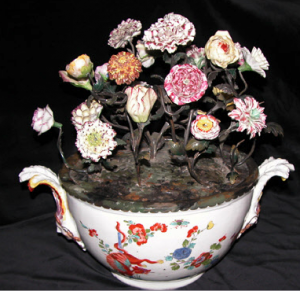
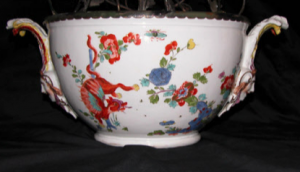
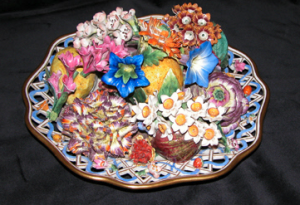
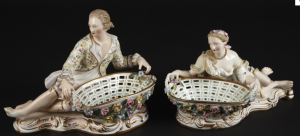
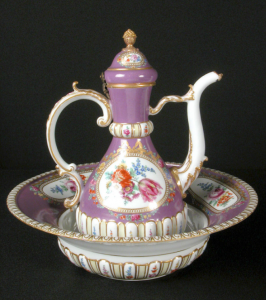
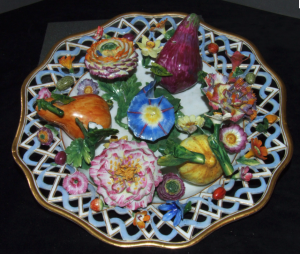
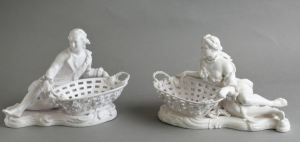
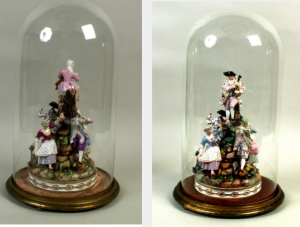
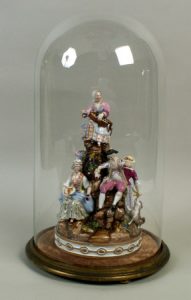

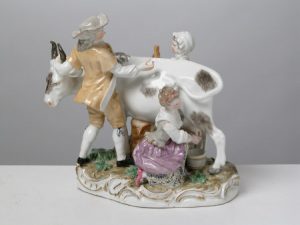
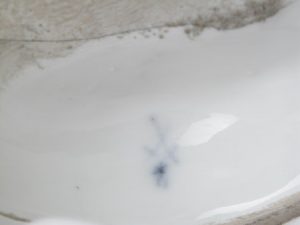
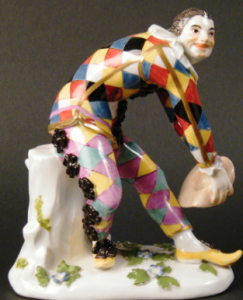
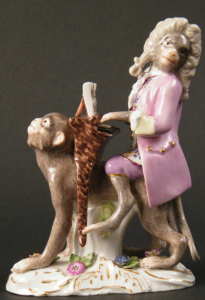
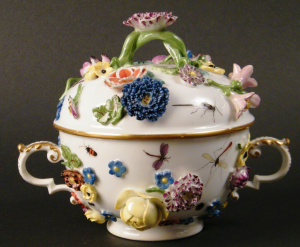
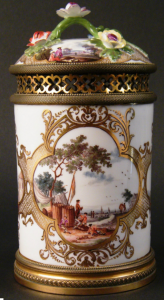
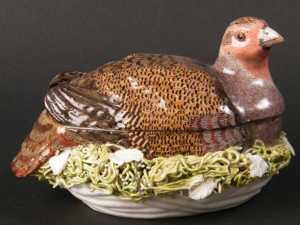
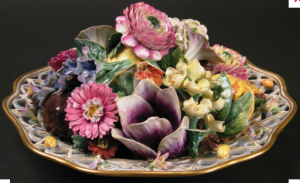
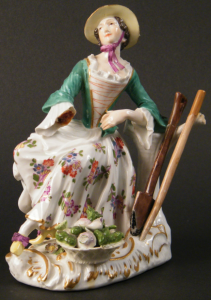
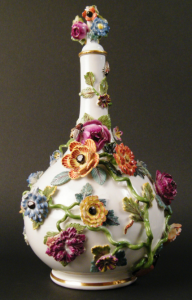
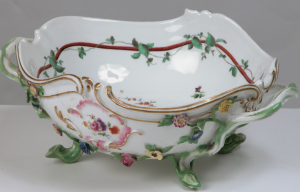
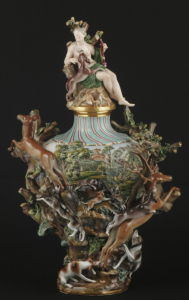
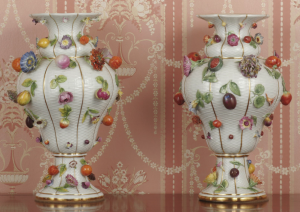
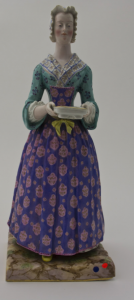
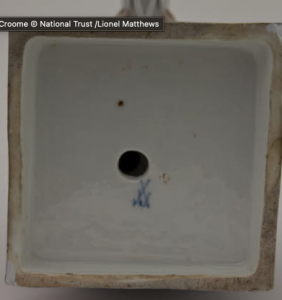

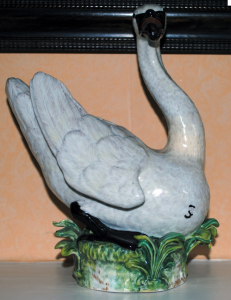
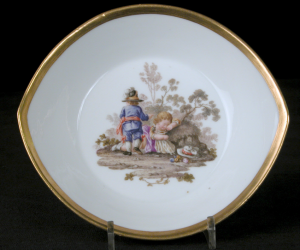
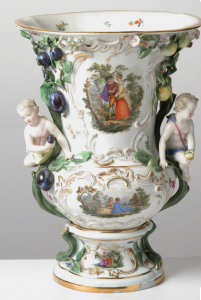
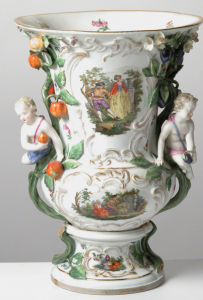
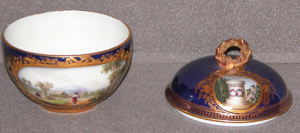
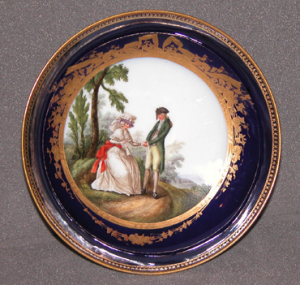
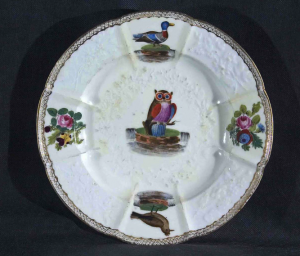
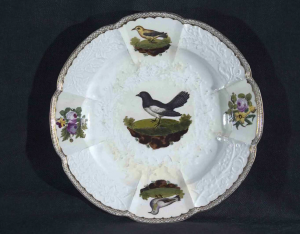
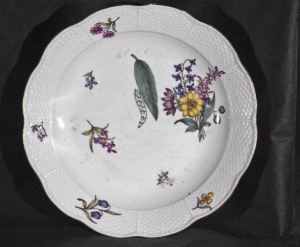
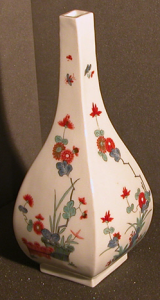
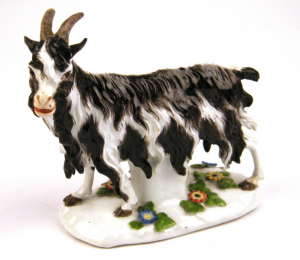
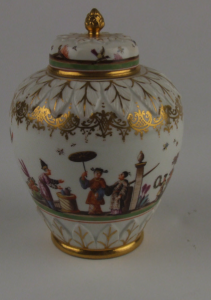
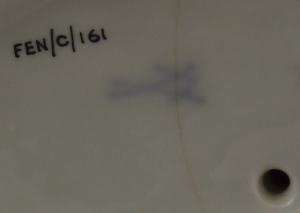
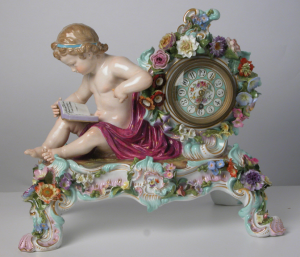
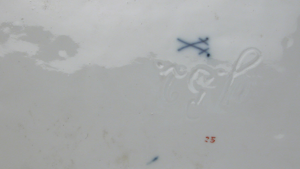
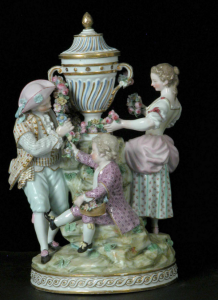
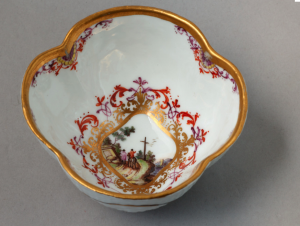
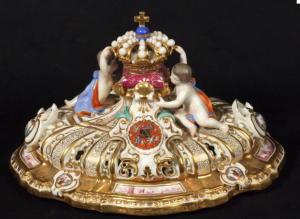
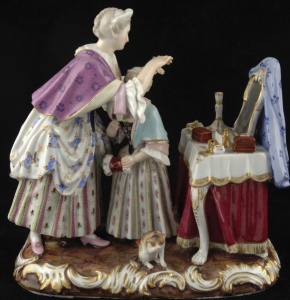
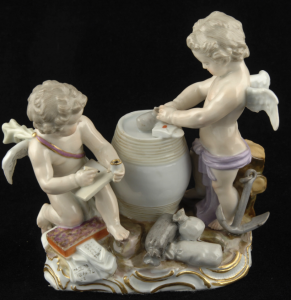

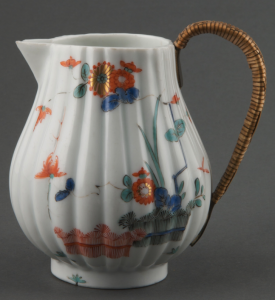
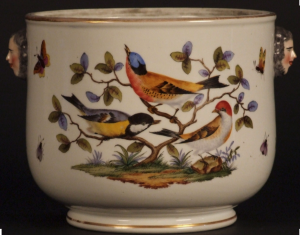
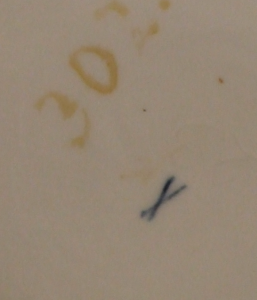
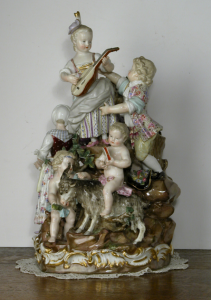
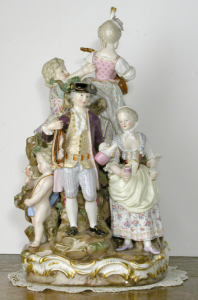
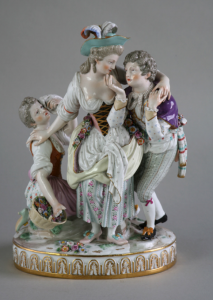
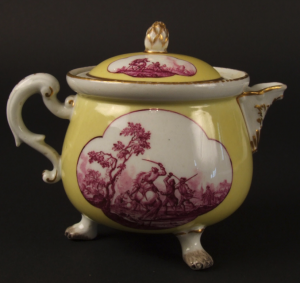
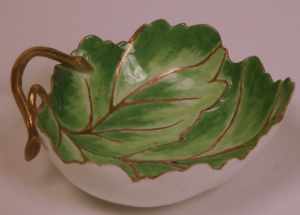
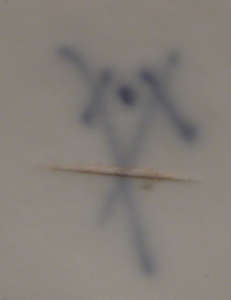
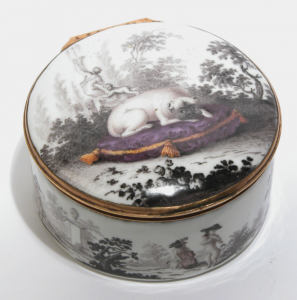
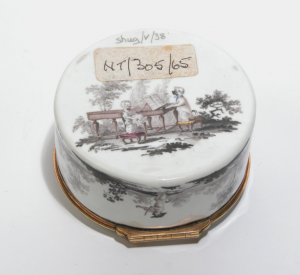
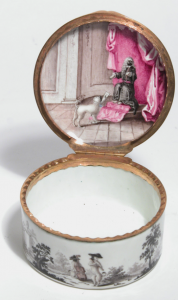
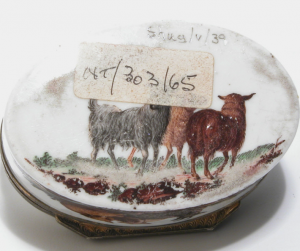 Shugborough Staffordshire
Shugborough Staffordshire
